Itinerary
At 55 degrees latitude south, Ushuaia (pronounced oo-swy-ah) is closer to the South Pole than to Argentina’s northern border with Bolivia. It is the capital and tourism base for Tierra del Fuego, the island at the southernmost tip of Argentina.Although its stark physical beauty is striking, Tierra del Fuego’s historical allure is based more on its mythical past than on rugged reality. The island was inhabited for 6,000 years by Yámana, Haush, Selk’nam, and Alakaluf Indians. But in 1902 Argentina, eager to populate Patagonia to bolster its territorial claims, moved to initiate an Ushuaian penal colony, establishing the permanent settlement of its most southern territories and, by implication, everything in between.When the prison closed in 1947, Ushuaia had a population of about 3,000, made up mainly of former inmates and prison staff. Today the Indians of Darwin’s “missing link” theory are long gone—wiped out by diseases brought by settlers and by indifference to their plight—and the 60,000 residents of Ushuaia are hitching their star to tourism.The city rightly (if perhaps too loudly) promotes itself as the southernmost city in the world (Puerto Williams, a few miles south on the Chilean side of the Beagle Channel, is a small town). You can make your way to the tourism office to get your clichéd, but oh-so-necessary, “Southernmost City in the World” passport stamp. Ushuaia feels like a frontier boomtown, at heart still a rugged, weather-beaten fishing village, but exhibiting the frayed edges of a city that quadrupled in size in the ’70s and ’80s and just keeps growing. Unpaved portions of Ruta 3, the last stretch of the Pan-American Highway, which connects Alaska to Tierra del Fuego, are finally being paved. The summer months (December through March) draw more than 120,000 visitors, and dozens of cruise ships. The city is trying to extend those visits with events like March’s Marathon at the End of the World and by increasing the gamut of winter activities buoyed by the excellent snow conditions.A terrific trail winds through the town up to the Martial Glacier, where a ski lift can help cut down a steep kilometer of your journey. The chaotic and contradictory urban landscape includes a handful of luxury hotels amid the concrete of public housing projects. Scores of “sled houses” (wooden shacks) sit precariously on upright piers, ready for speedy displacement to a different site. But there are also many small, picturesque homes with tiny, carefully tended gardens. Many of the newer homes are built in a Swiss-chalet style, reinforcing the idea that this is a town into which tourism has breathed new life. At the same time, the weather-worn pastel colors that dominate the town’s landscape remind you that Ushuaia was once just a tiny fishing village, snuggled at the end of the Earth.As you stand on the banks of the Canal Beagle (Beagle Channel) near Ushuaia, the spirit of the farthest corner of the world takes hold. What stands out is the light: at sundown the landscape is cast in a subdued, sensual tone; everything feels closer, softer, and more human in dimension despite the vastness of the setting. The snowcapped mountains reflect the setting sun back onto a stream rolling into the channel, as nearby peaks echo their image—on a windless day—in the still waters.Above the city rise the last mountains of the Andean Cordillera, and just south and west of Ushuaia they finally vanish into the often-stormy sea. Snow whitens the peaks well into summer. Nature is the principal attraction here, with trekking, fishing, horseback riding, wildlife spotting, and sailing among the most rewarding activities, especially in the Parque Nacional Tierra del Fuego (Tierra del Fuego National Park).
Day programme:
You will begin your journey in Ushuaia, a small but bustling port town at the tip of South America. This Argentine town is an ideal gateway for you to explore the southern extent of Patagonia while preparing for your adventure ahead. Enjoy the mountains or sample handcrafted chocolate at a café in town.
At 55 degrees latitude south, Ushuaia (pronounced oo-swy-ah) is closer to the South Pole than to Argentina’s northern border with Bolivia. It is the capital and tourism base for Tierra del Fuego, the island at the southernmost tip of Argentina.Although its stark physical beauty is striking, Tierra del Fuego’s historical allure is based more on its mythical past than on rugged reality. The island was inhabited for 6,000 years by Yámana, Haush, Selk’nam, and Alakaluf Indians. But in 1902 Argentina, eager to populate Patagonia to bolster its territorial claims, moved to initiate an Ushuaian penal colony, establishing the permanent settlement of its most southern territories and, by implication, everything in between.When the prison closed in 1947, Ushuaia had a population of about 3,000, made up mainly of former inmates and prison staff. Today the Indians of Darwin’s “missing link” theory are long gone—wiped out by diseases brought by settlers and by indifference to their plight—and the 60,000 residents of Ushuaia are hitching their star to tourism.The city rightly (if perhaps too loudly) promotes itself as the southernmost city in the world (Puerto Williams, a few miles south on the Chilean side of the Beagle Channel, is a small town). You can make your way to the tourism office to get your clichéd, but oh-so-necessary, “Southernmost City in the World” passport stamp. Ushuaia feels like a frontier boomtown, at heart still a rugged, weather-beaten fishing village, but exhibiting the frayed edges of a city that quadrupled in size in the ’70s and ’80s and just keeps growing. Unpaved portions of Ruta 3, the last stretch of the Pan-American Highway, which connects Alaska to Tierra del Fuego, are finally being paved. The summer months (December through March) draw more than 120,000 visitors, and dozens of cruise ships. The city is trying to extend those visits with events like March’s Marathon at the End of the World and by increasing the gamut of winter activities buoyed by the excellent snow conditions.A terrific trail winds through the town up to the Martial Glacier, where a ski lift can help cut down a steep kilometer of your journey. The chaotic and contradictory urban landscape includes a handful of luxury hotels amid the concrete of public housing projects. Scores of “sled houses” (wooden shacks) sit precariously on upright piers, ready for speedy displacement to a different site. But there are also many small, picturesque homes with tiny, carefully tended gardens. Many of the newer homes are built in a Swiss-chalet style, reinforcing the idea that this is a town into which tourism has breathed new life. At the same time, the weather-worn pastel colors that dominate the town’s landscape remind you that Ushuaia was once just a tiny fishing village, snuggled at the end of the Earth.As you stand on the banks of the Canal Beagle (Beagle Channel) near Ushuaia, the spirit of the farthest corner of the world takes hold. What stands out is the light: at sundown the landscape is cast in a subdued, sensual tone; everything feels closer, softer, and more human in dimension despite the vastness of the setting. The snowcapped mountains reflect the setting sun back onto a stream rolling into the channel, as nearby peaks echo their image—on a windless day—in the still waters.Above the city rise the last mountains of the Andean Cordillera, and just south and west of Ushuaia they finally vanish into the often-stormy sea. Snow whitens the peaks well into summer. Nature is the principal attraction here, with trekking, fishing, horseback riding, wildlife spotting, and sailing among the most rewarding activities, especially in the Parque Nacional Tierra del Fuego (Tierra del Fuego National Park).
Day programme:
Embarkation will occur in the late afternoon, after which your vessel will sail down the historic Beagle Channel, which transects the Tierra del Fuego archipelago in the extreme south of South America. Expect an air of anticipation as you depart—the next time you see land, you’ll be on the world’s most southern continent!
Day programme:
Your days at sea are filled with presentations led by your Expedition Team on photography, wildlife, glaciology, and history. In between presentations, spend time on deck looking for wildlife, or chatting with your shipmates over a drink at the bar.
Day programme:
Your days at sea are filled with presentations led by your Expedition Team on photography, wildlife, glaciology, and history. In between presentations, spend time on deck looking for wildlife, or chatting with your shipmates over a drink at the bar.
Some 770 kilometers (478 miles) south of Cape Horn, the South Shetland Islands are usually the first land seen in Antarctica. Separated from the Antarctic Peninsula by the Bransfield Strait, nine major islands make up the group. The region was the first to be exploited by sealers in the early 19th century, and because of its proximity to South America, it still is the most visited by scientists and tourists. Chinstrap, Adelie, Gentoo and Macaroni Penguins all breed here. In addition, because it is the warmest part of the continent, large moss beds as well as orange, black, grey and green lichens grow –even hair grass and pearlwort manage to survive. Leopard seals, Weddell seals, crabeater seals, Southern elephant seals and Antarctic fur seals can be seen in the water and on the beaches.
Day programme:
The most common reaction upon reaching the 7th Continent is a sense of reverence and awe. The experience is beyond words, since few places are as untouched and enduring as Antarctica. You will begin to appreciate why this region has long captivated the attention of explorers and travelers alike. Every time we visit Antarctica, we witness something new or unexpected, which means that your expedition will be unlike any other—creating a unique, personal experience.Each day, you will take Zodiac excursions from the ship to explore glaciated bays, channels and landing sites. Your Expedition Team will take care of you at each landing, whether you are hiking the Antarctic landscape, visiting a research station or consorting with chinstrap, Adélie and gentoo penguins, all of which can be found here. Keep an eye out for Weddell, fur, crabeater and leopard seals as well as curious whales, such as humpbacks, minkes, or perhaps orcas while on a Zodiac cruise. Each excursion will present a new array of creatures to fascinate you and keep your camera busy.Amid the serene silence of Antarctica, noisy interludes become indelible memories, such as penguins squabbling over prized pebbles, or the boom and crack of a calving glacier.Every day will be different, having been carefully crafted by your Expedition Team to inspire and educate you about this wonderful part of the world.
Remote and otherworldly, Antarctic is irresistible for its spectacular iceberg sculptures and calving glaciers, and for the possibility of up-close encounters with marine mammals and the iconic penguins. The Antarctic Peninsula – the main peninsula closest to South America – has a human history of almost 200 years, with explorers, sealers, whalers, and scientists who have come to work, and eventually intrepid visitors coming to enjoy this pristine and remote wilderness. It is a region of protected bays, unscaled snow-capped mountains, vast glaciers and a few places where whalers or scientists have worked. Just as irresistible are the many Gentoo and Chinstrap Penguin colonies, the seals basking on ice floes, the whales and orcas.
Day programme:
The most common reaction upon reaching the 7th Continent is a sense of reverence and awe. The experience is beyond words, since few places are as untouched and enduring as Antarctica. You will begin to appreciate why this region has long captivated the attention of explorers and travelers alike. Every time we visit Antarctica, we witness something new or unexpected, which means that your expedition will be unlike any other—creating a unique, personal experience.Each day, you will take Zodiac excursions from the ship to explore glaciated bays, channels and landing sites. Your Expedition Team will take care of you at each landing, whether you are hiking the Antarctic landscape, visiting a research station or consorting with chinstrap, Adélie and gentoo penguins, all of which can be found here. Keep an eye out for Weddell, fur, crabeater and leopard seals as well as curious whales, such as humpbacks, minkes, or perhaps orcas while on a Zodiac cruise. Each excursion will present a new array of creatures to fascinate you and keep your camera busy.Amid the serene silence of Antarctica, noisy interludes become indelible memories, such as penguins squabbling over prized pebbles, or the boom and crack of a calving glacier.Every day will be different, having been carefully crafted by your Expedition Team to inspire and educate you about this wonderful part of the world.
Remote and otherworldly, Antarctic is irresistible for its spectacular iceberg sculptures and calving glaciers, and for the possibility of up-close encounters with marine mammals and the iconic penguins. The Antarctic Peninsula – the main peninsula closest to South America – has a human history of almost 200 years, with explorers, sealers, whalers, and scientists who have come to work, and eventually intrepid visitors coming to enjoy this pristine and remote wilderness. It is a region of protected bays, unscaled snow-capped mountains, vast glaciers and a few places where whalers or scientists have worked. Just as irresistible are the many Gentoo and Chinstrap Penguin colonies, the seals basking on ice floes, the whales and orcas.
Day programme:
The most common reaction upon reaching the 7th Continent is a sense of reverence and awe. The experience is beyond words, since few places are as untouched and enduring as Antarctica. You will begin to appreciate why this region has long captivated the attention of explorers and travelers alike. Every time we visit Antarctica, we witness something new or unexpected, which means that your expedition will be unlike any other—creating a unique, personal experience.Each day, you will take Zodiac excursions from the ship to explore glaciated bays, channels and landing sites. Your Expedition Team will take care of you at each landing, whether you are hiking the Antarctic landscape, visiting a research station or consorting with chinstrap, Adélie and gentoo penguins, all of which can be found here. Keep an eye out for Weddell, fur, crabeater and leopard seals as well as curious whales, such as humpbacks, minkes, or perhaps orcas while on a Zodiac cruise. Each excursion will present a new array of creatures to fascinate you and keep your camera busy.Amid the serene silence of Antarctica, noisy interludes become indelible memories, such as penguins squabbling over prized pebbles, or the boom and crack of a calving glacier.Every day will be different, having been carefully crafted by your Expedition Team to inspire and educate you about this wonderful part of the world.
Some 770 kilometers (478 miles) south of Cape Horn, the South Shetland Islands are usually the first land seen in Antarctica. Separated from the Antarctic Peninsula by the Bransfield Strait, nine major islands make up the group. The region was the first to be exploited by sealers in the early 19th century, and because of its proximity to South America, it still is the most visited by scientists and tourists. Chinstrap, Adelie, Gentoo and Macaroni Penguins all breed here. In addition, because it is the warmest part of the continent, large moss beds as well as orange, black, grey and green lichens grow –even hair grass and pearlwort manage to survive. Leopard seals, Weddell seals, crabeater seals, Southern elephant seals and Antarctic fur seals can be seen in the water and on the beaches.
Day programme:
The most common reaction upon reaching the 7th Continent is a sense of reverence and awe. The experience is beyond words, since few places are as untouched and enduring as Antarctica. You will begin to appreciate why this region has long captivated the attention of explorers and travelers alike. Every time we visit Antarctica, we witness something new or unexpected, which means that your expedition will be unlike any other—creating a unique, personal experience.Each day, you will take Zodiac excursions from the ship to explore glaciated bays, channels and landing sites. Your Expedition Team will take care of you at each landing, whether you are hiking the Antarctic landscape, visiting a research station or consorting with chinstrap, Adélie and gentoo penguins, all of which can be found here. Keep an eye out for Weddell, fur, crabeater and leopard seals as well as curious whales, such as humpbacks, minkes, or perhaps orcas while on a Zodiac cruise. Each excursion will present a new array of creatures to fascinate you and keep your camera busy.Amid the serene silence of Antarctica, noisy interludes become indelible memories, such as penguins squabbling over prized pebbles, or the boom and crack of a calving glacier.Every day will be different, having been carefully crafted by your Expedition Team to inspire and educate you about this wonderful part of the world.
Day programme:
The journey back across the Drake Passage provides final opportunities to enjoy the crisp Antarctic air Spend time on the deck, watching for seabirds and scouting for whales, enjoy presentations by your Expedition Team and celebrate the experiences shared exploring Antarctica.
Day programme:
The journey back across the Drake Passage provides final opportunities to enjoy the crisp Antarctic air Spend time on the deck, watching for seabirds and scouting for whales, enjoy presentations by your Expedition Team and celebrate the experiences shared exploring Antarctica.
At 55 degrees latitude south, Ushuaia (pronounced oo-swy-ah) is closer to the South Pole than to Argentina’s northern border with Bolivia. It is the capital and tourism base for Tierra del Fuego, the island at the southernmost tip of Argentina.Although its stark physical beauty is striking, Tierra del Fuego’s historical allure is based more on its mythical past than on rugged reality. The island was inhabited for 6,000 years by Yámana, Haush, Selk’nam, and Alakaluf Indians. But in 1902 Argentina, eager to populate Patagonia to bolster its territorial claims, moved to initiate an Ushuaian penal colony, establishing the permanent settlement of its most southern territories and, by implication, everything in between.When the prison closed in 1947, Ushuaia had a population of about 3,000, made up mainly of former inmates and prison staff. Today the Indians of Darwin’s “missing link” theory are long gone—wiped out by diseases brought by settlers and by indifference to their plight—and the 60,000 residents of Ushuaia are hitching their star to tourism.The city rightly (if perhaps too loudly) promotes itself as the southernmost city in the world (Puerto Williams, a few miles south on the Chilean side of the Beagle Channel, is a small town). You can make your way to the tourism office to get your clichéd, but oh-so-necessary, “Southernmost City in the World” passport stamp. Ushuaia feels like a frontier boomtown, at heart still a rugged, weather-beaten fishing village, but exhibiting the frayed edges of a city that quadrupled in size in the ’70s and ’80s and just keeps growing. Unpaved portions of Ruta 3, the last stretch of the Pan-American Highway, which connects Alaska to Tierra del Fuego, are finally being paved. The summer months (December through March) draw more than 120,000 visitors, and dozens of cruise ships. The city is trying to extend those visits with events like March’s Marathon at the End of the World and by increasing the gamut of winter activities buoyed by the excellent snow conditions.A terrific trail winds through the town up to the Martial Glacier, where a ski lift can help cut down a steep kilometer of your journey. The chaotic and contradictory urban landscape includes a handful of luxury hotels amid the concrete of public housing projects. Scores of “sled houses” (wooden shacks) sit precariously on upright piers, ready for speedy displacement to a different site. But there are also many small, picturesque homes with tiny, carefully tended gardens. Many of the newer homes are built in a Swiss-chalet style, reinforcing the idea that this is a town into which tourism has breathed new life. At the same time, the weather-worn pastel colors that dominate the town’s landscape remind you that Ushuaia was once just a tiny fishing village, snuggled at the end of the Earth.As you stand on the banks of the Canal Beagle (Beagle Channel) near Ushuaia, the spirit of the farthest corner of the world takes hold. What stands out is the light: at sundown the landscape is cast in a subdued, sensual tone; everything feels closer, softer, and more human in dimension despite the vastness of the setting. The snowcapped mountains reflect the setting sun back onto a stream rolling into the channel, as nearby peaks echo their image—on a windless day—in the still waters.Above the city rise the last mountains of the Andean Cordillera, and just south and west of Ushuaia they finally vanish into the often-stormy sea. Snow whitens the peaks well into summer. Nature is the principal attraction here, with trekking, fishing, horseback riding, wildlife spotting, and sailing among the most rewarding activities, especially in the Parque Nacional Tierra del Fuego (Tierra del Fuego National Park).
Day programme:
You will arrive in Ushuaia in the morning, which allows for you to continue your adventure onward or catch your flights home.

Located on Decks 5 and 6, and approximately 355 sq. ft. (33 sq. m) in size, these cabins have one double or two single beds, and a 110 sq. ft. (10 sq. m) walk-out balcony with access from sitting room and bedroom. A separate sitting area with sofa, refrigerator, TV, state of the art “infotainment” system, and private bathroom with shower, dual vanity, and bathtub is also featured in each cabin.

Located on Decks 5 and 6, and approximately 278 sq. ft. (26 sq. m) in size, these cabins have one double or two single beds, and a 110 sq. ft. (10 sq. m) walk-out balcony with access from sitting room and bedroom. A separate sitting area with sofa, walk-in closet, refrigerator, TV, state of the art “infotainment” system, and private bathroom with shower is also featured in each cabin.
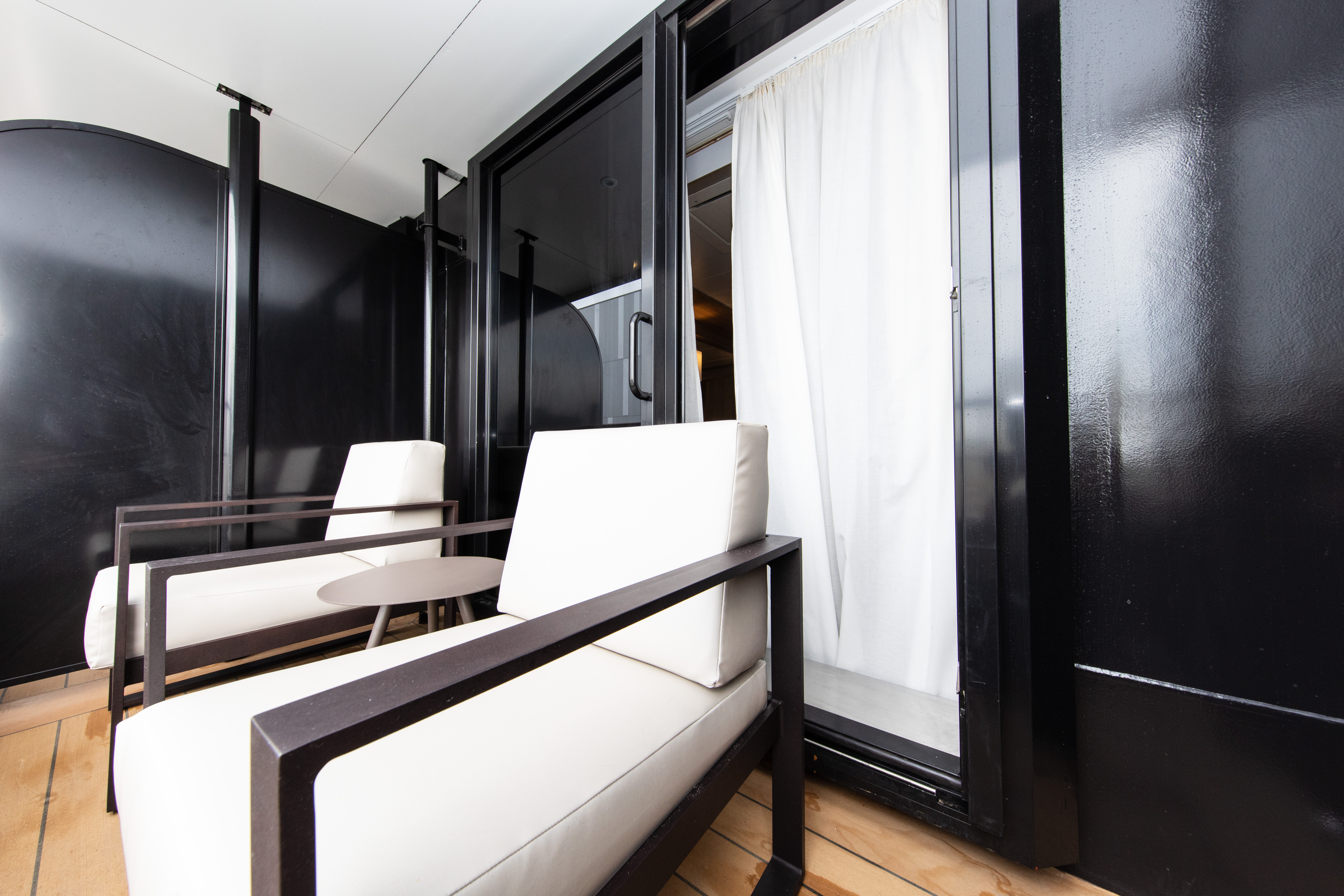
Located on Decks 5 and 6, and approximately 215 sq. ft. (20 sq. m) in size, these cabins have one double or two single beds, and a 55 sq. ft. (5 sq. m) walk-out balcony. A sitting area with sofa, refrigerator, TV, state of the art “infotainment” system, and private bathroom with shower is also featured in each cabin.

Located on Decks 5 and 6, and approximately 270 sq. ft. (25 sq. m) in size, these cabins have one double or two single beds, and a floor-to-ceiling glass French balcony. A sitting area with sofa, refrigerator, TV, state of the art “infotainment” system, and private bathroom with shower is also featured in each cabin.

Located on Deck 5, and approximately 334 sq. ft. (31 sq. m) in size, these cabins have one double or two single beds, and a 110 sq. ft. (10 sq. m) walk-out balcony with access from sitting room and bedroom. A separate sitting area with sofa, double closets, refrigerator, TV, state of the art “infotainment” system, and private bathroom with shower is also featured in each cabin.

Located on Deck 6, and approximately 242 sq. ft. (22.5 sq. m) in size, these cabins have one double or two single beds, and a 55 sq. ft. (5 sq. m) walk-out balcony. A separate combo sitting area/bedroom with a sofa bed and additional closet is around the corner, and a refrigerator, TV, state of the art “infotainment” system, and private bathroom with shower is also featured in each cabin.

There is one dining room located on Deck 4. If there is one constant at sea, it is that you’ll enjoy delicious meals on a daily basis. While meal times may change due to landings and wildlife encounters, you’ll always be served three meals a day. Hours of operation will be posted around the ship, as they are subject to change based on the activities planned for your voyage each day.
There is one seating for all passengers at breakfast, lunch and dinner. The dining room has an open seating policy.
Assortments of fresh-baked cookies and/or pastries are offered each afternoon. There is also a selection of hot and cold snacks available in the lounge during cocktail hour, expedition activities permitting.
Breakfasts and lunches are normally served buffet style, while dinners are served plated. À la carte meals are made at the time of your order, allowing our chefs to prepare each dish to your individual needs. Working in a small kitchen, our chefs are able to monitor and control the quality of food being served, ensuring you receive top quality meals during the course of your expedition.

The perfect polar expedition doesn’t just happen. It takes a team of talented, knowledgeable and experienced professionals to bring it all together. Our Expedition Team is comprised of seasoned veterans with rich backgrounds in marine biology, history, glaciology, geology and more. With the highest staff-to-guest ratio in the industry, our Expedition Teams safely deliver your trip-of-a-lifetime to maximize your polar adventure every step of the way.
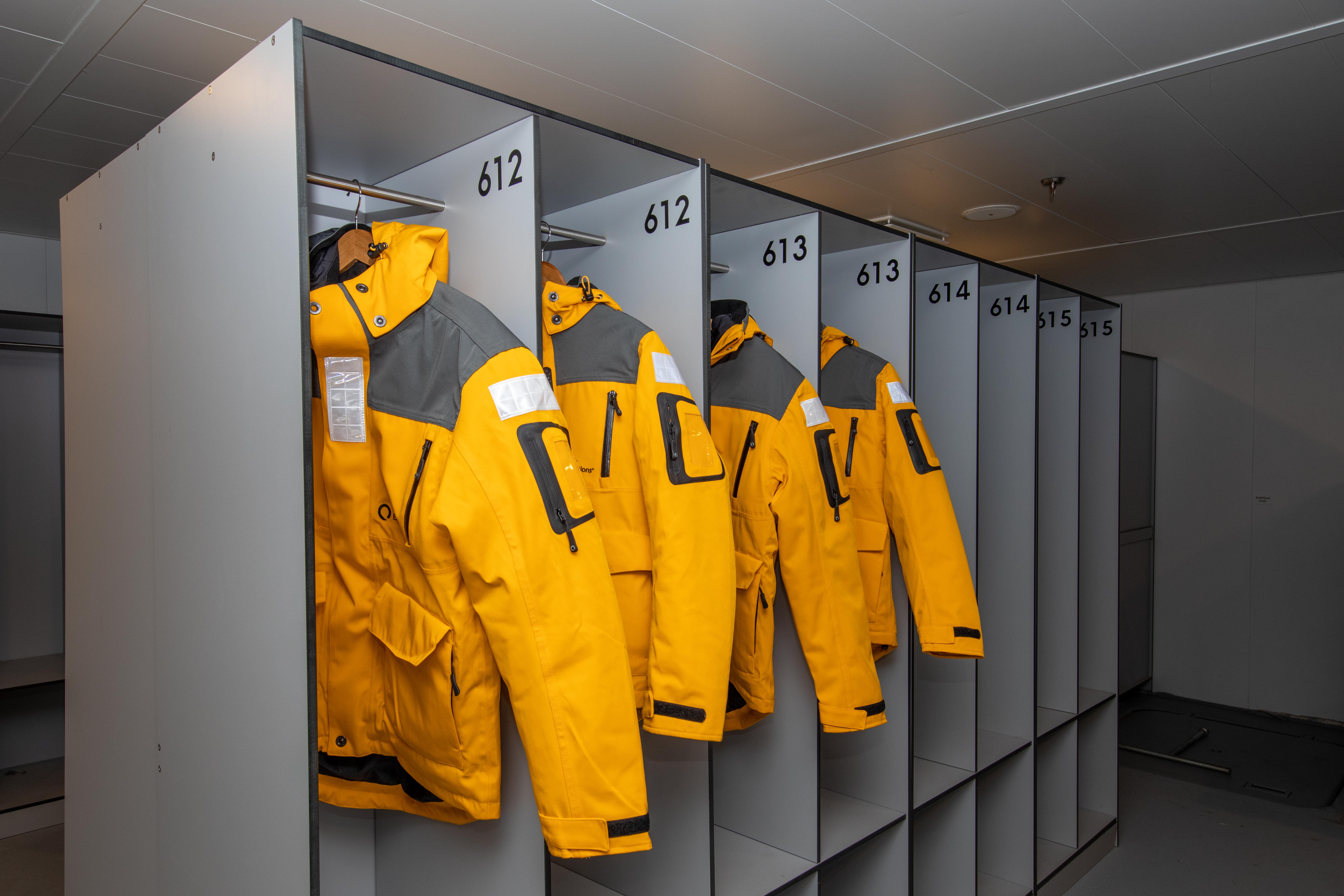
The Mudroom on Deck 3 enables you to comfortably prepare for, and disembark from, Zodiac excursions and shore landings and is conveniently located adjacent to zodiac embarkation points.
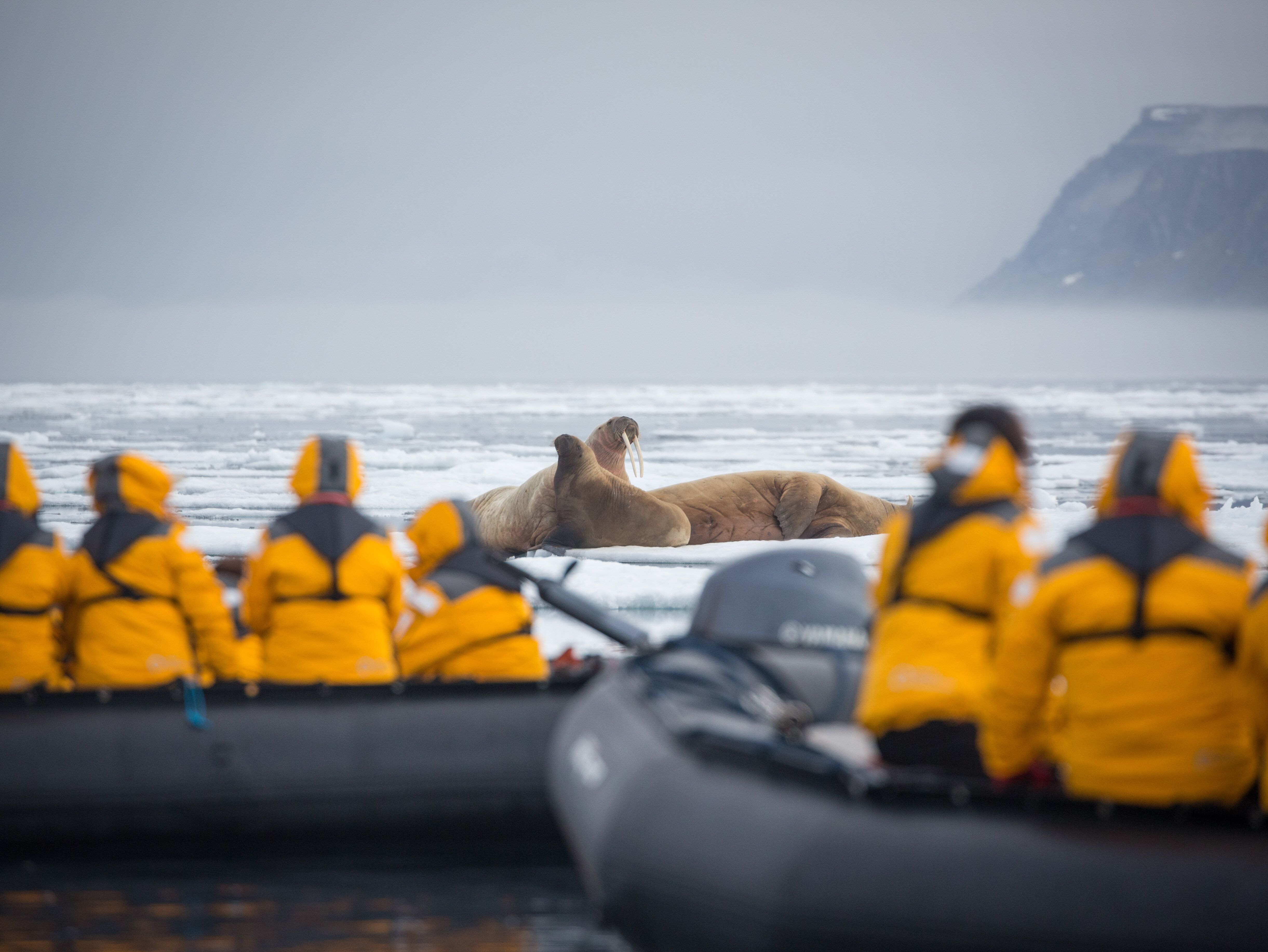
Zodiacs are used for transferring you ashore, transporting your luggage when necessary and for taking you ocean-level cruising among icebergs, whales and seabirds. During the expedition, you will visit remote and isolated sites that are accessible only by Zodiac.
These large, heavy-duty inflatable vessels are extremely safe and were specially designed for expedition work. Zodiacs are the workhorses of Polar expeditions. Separate air compartments retain a large reserve of buoyancy even if these sturdy boats are damaged. Their flat bottom design permits the craft to land directly onto the cobble and ice-strewn beaches that you will encounter on your Polar expedition.
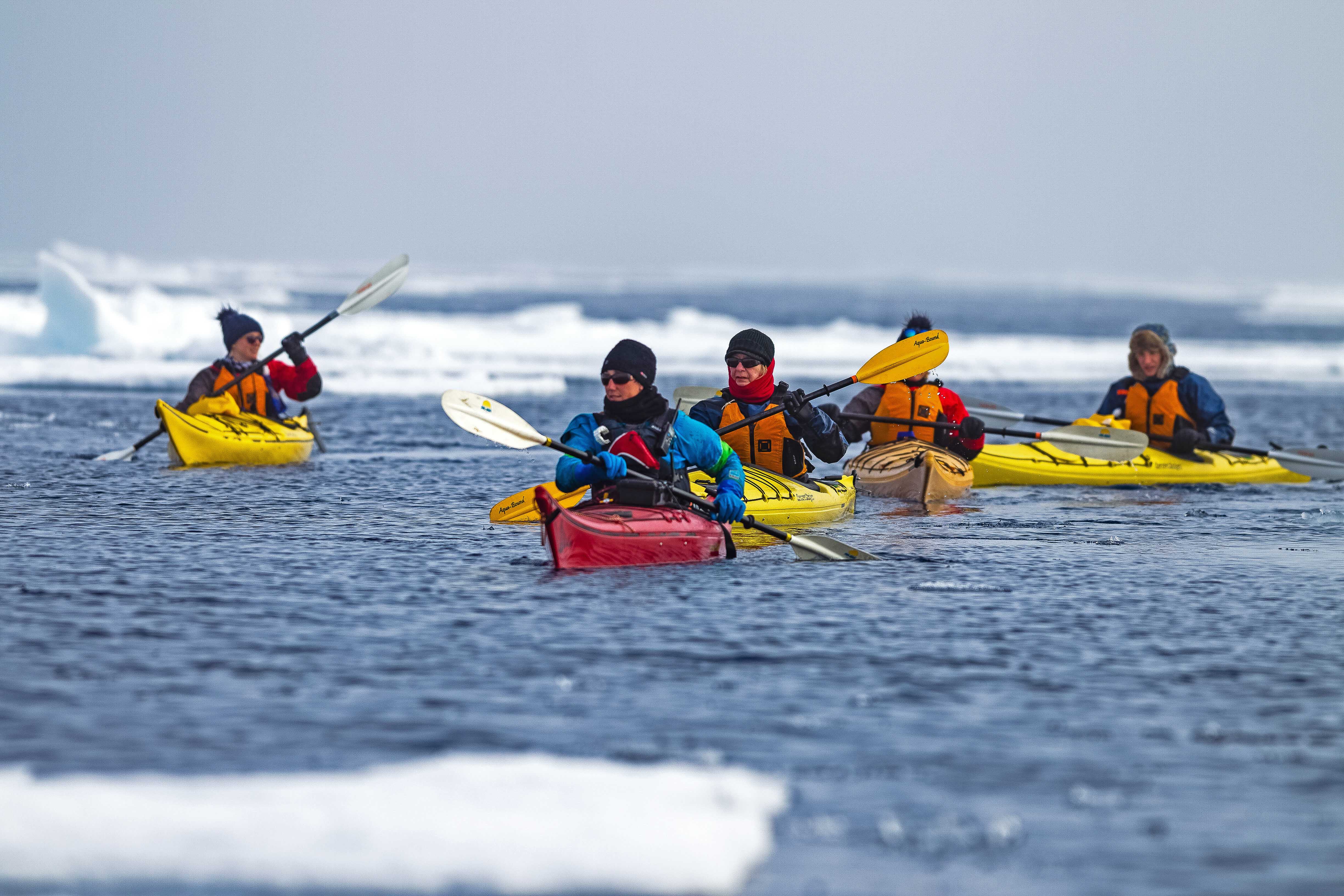
Sea kayaking is offered on all of our departures and you require no previous experience to enjoy this activity. Our sea kayaks are the ideal means by which to get some good exercise and explore the cliffs and shores of the various visitor sites around the archipelago. A typical cruise week offers great opportunities to go kayaking around secluded coves, shores, mangrove estuaries and beautiful beaches. Galapagos penguins, flightless cormorants, sea lions and many other animals can be seen up close on a kayak and even as they swim.
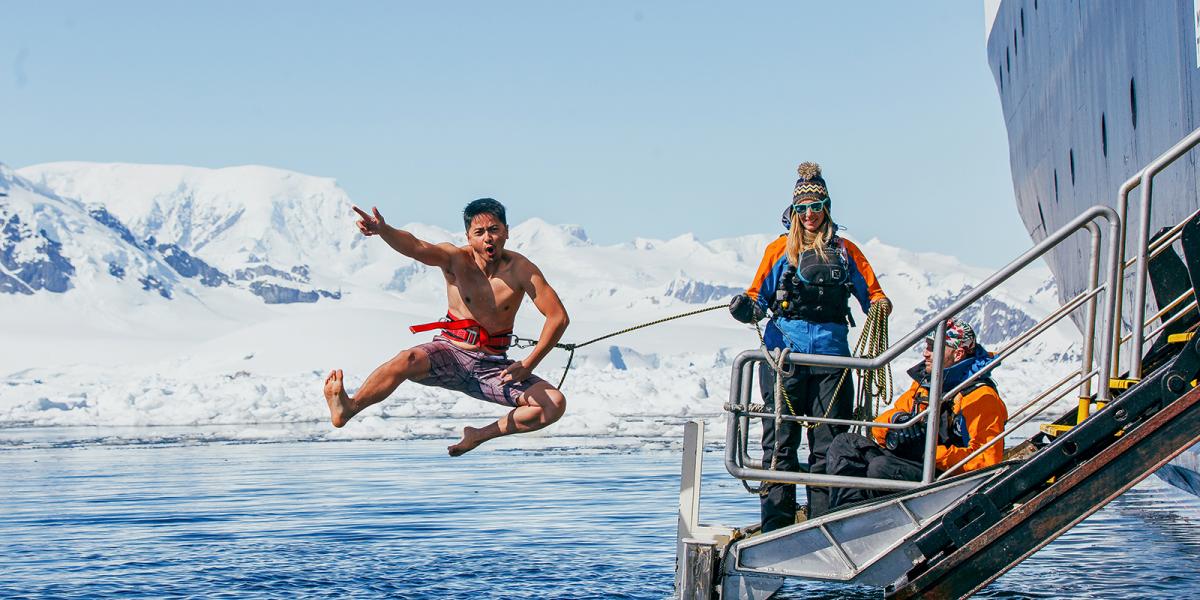
The Polar Plunge is scheduled once during each voyage. Throughout the journey, the Expedition Leader and Captain constantly monitor conditions in order to choose the optimal time and location. The Polar Plunge sometimes takes place onshore or, in many cases, from the gangway or Zodiac. All participants wear a tethered harness and plunge into the polar waters from the side of Zodiac or safety of the gangplank cheered on, of course, by fellow passengers and Expedition Team.
Safety is paramount—the onboard physician always attends the Polar Plunge. Guides in survival gear circle the area in Zodiacs as guests take their turn jumping or cannon-balling into the polar waters.
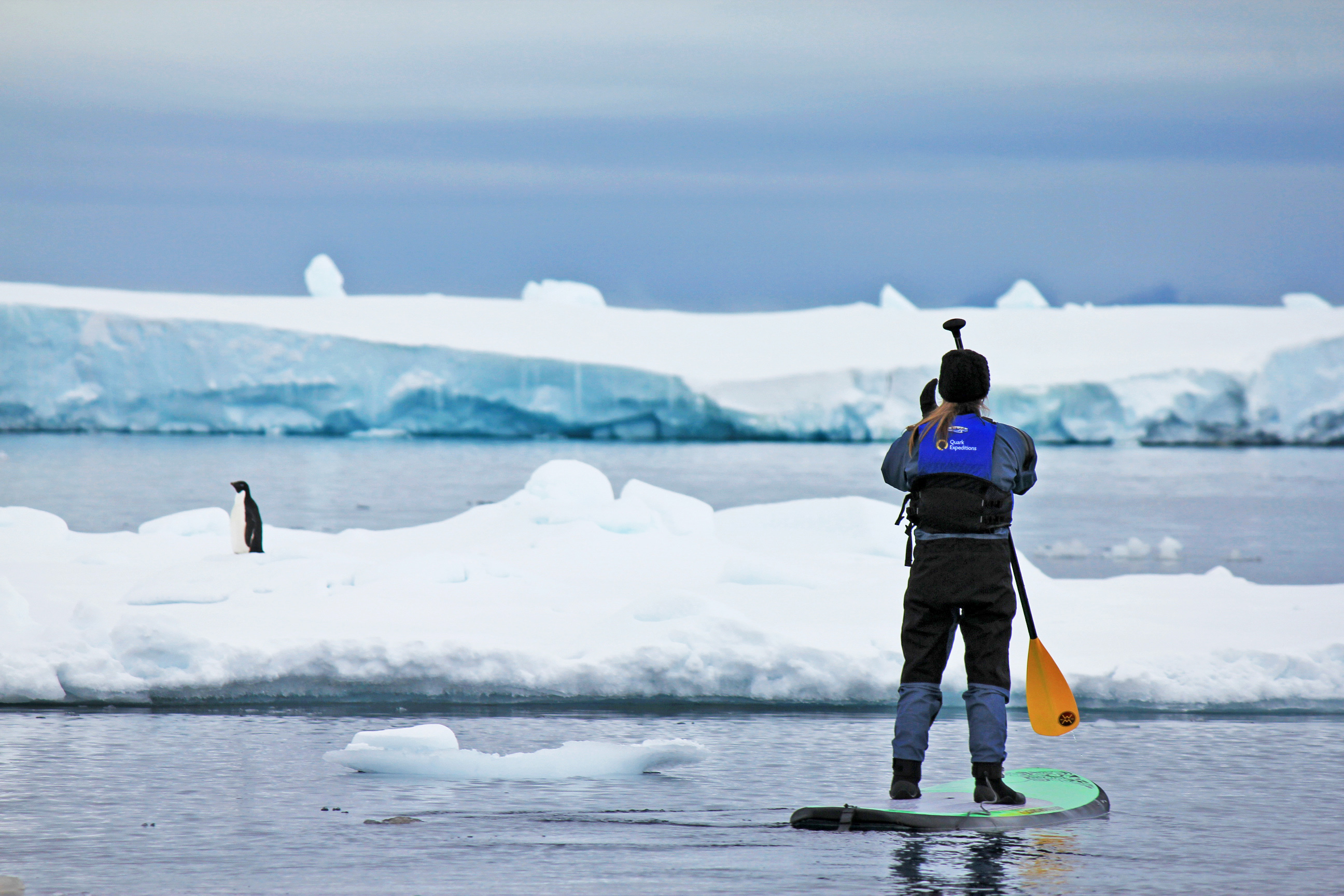
Stand-up Paddleboarding, popularly known as SUPing, originated in Hawaii. Quark Expeditions is the first company to bring this watersport all the way to Antarctica.
SUPing combines the immersive experience of kayaking but in a standing position. Participants, if they prefer, can kneel, sit or even lie down and stare up at the azure Antarctic sky. Because of their wide base and tail fins, SUP boards are quite stable, enabling participants – after a bit of practice – to stop staring at their feet and admire the surrounding scenery. Imagine seeing Gentoo penguins gliding below you, or making eye contact with a Weddell seal lying on a piece of ice as you paddle by.
Guests receive on-ship and on-water instruction from a qualified SUP guide. In addition, a safety driver (in a Zodiac) stays within range to offer assistance.

Explore the ocean from a more intimate vantage point on a sit-on-top kayak. No experience is required to manoeuvre these very stable kayaks, allowing you to enjoy an unforgettable experience on the water, taking in breathtaking landscapes and wildlife. Whether it’s your first time in a kayak or you want greater flexibility to try other Adventure options, this shorter excursion is for you.
Paddling in the Polar Regions is highly weather-dependent and a one-time experience. Your kayak guides will attempt to take you out on the water for 1-1.5 hours of paddling. Offered on most voyages, spaces are limited. All equipment, guides and instructions are provided by Quark.
Pricing subject to change based on season. Please proceed to checkout or contact a Polar Travel Adviser for more details.
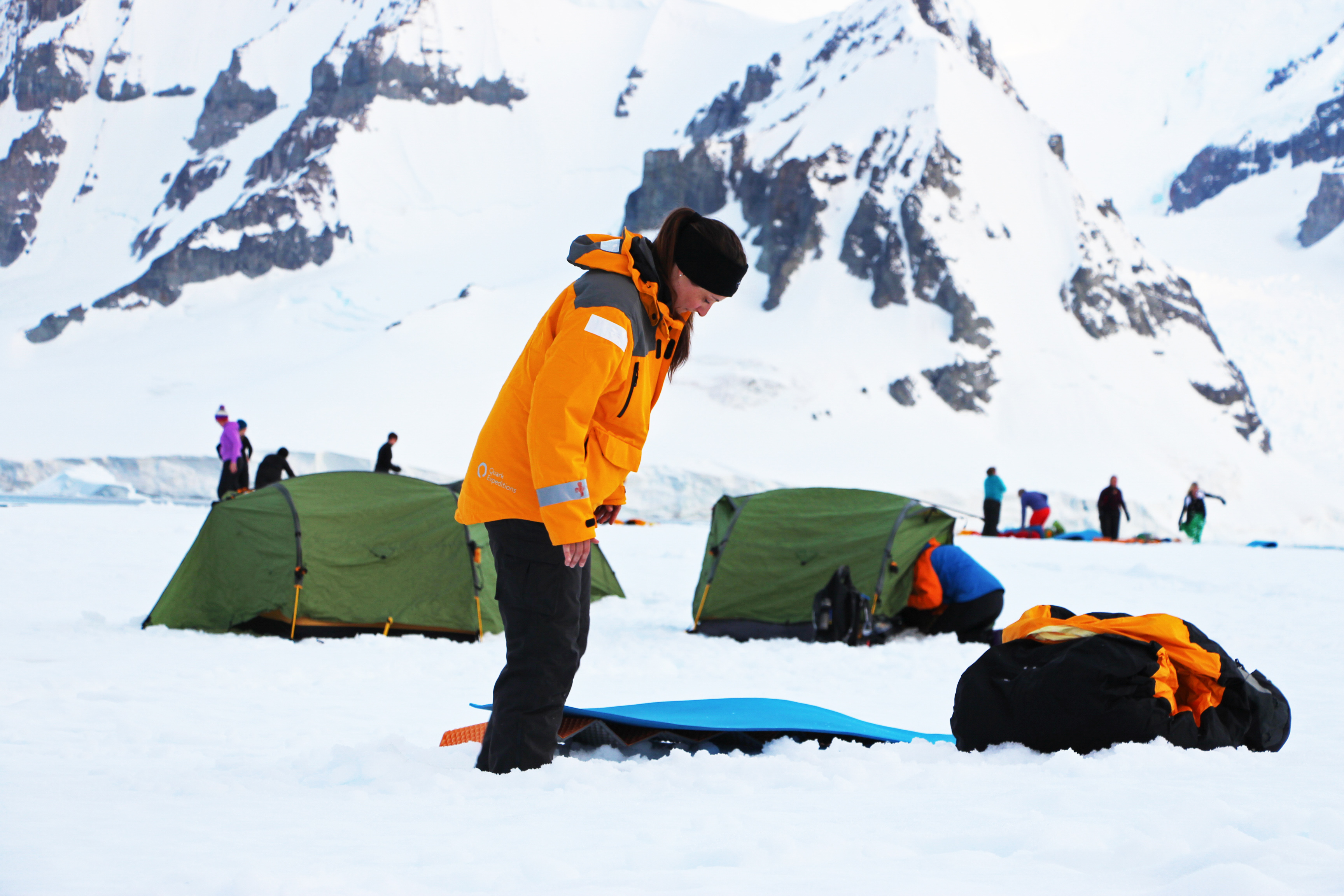
Imagine for a moment, staring at the stars in the indigo glow of an Antarctic night as you bed down for the night outside in the elements. The buzz of your daily life becomes a distant memory as you listen to the bray of penguin, the ethereal calls of the Weddell sea – even the exhalation of a humpback whale. And then you fall asleep.
Antarctic Camping with Quark Expeditions is an unforgettable experience. After dinner onboard, you’ll be escorted ashore by Zodiac to camp out on the snow for the night in your ready-to-roll bivy sack (tents can be used upon request). Once you decide on your spot, you set up camp and enjoy the peace as the Antarctic night unfolds.
Camping in Antarctica is limited to 50 participants, all of whom will be briefed beforehand on the principals of basic camping. Prior to you settling down for the night, Quark Expeditions staff will prepare the site, including setting up a perimeter in safe, flat to gently-sloping and beautiful site. You’re free to choose where (within the perimeters) you want to settle down for the night.
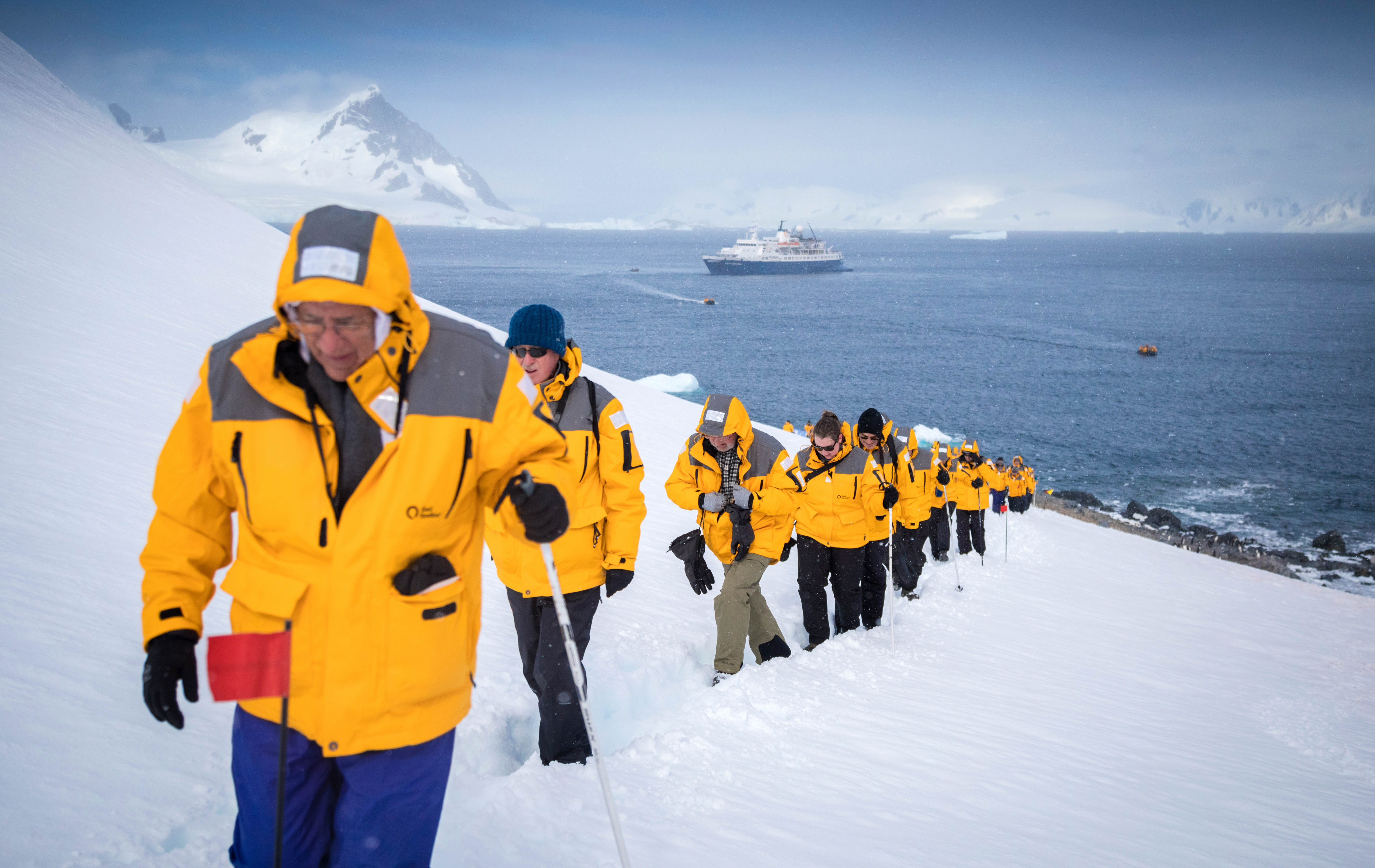
Hiking in the polar regions differs from your typical trail experience. Here, in a tree-less terrain, you are the tallest figure on the landscape as you walk over spongy tundra, crusty snow or sandy beaches in remotes parts of the Arctic and Antarctica. Stepping ashore anywhere in the polar regions means you’re not a distant observer.
Our organized hikes range from short jaunts to the top of lookouts or visits to see wildlife or longer walks of several kilometers over ice and rock and snow. Hiking excursions may last from two to three hours with plenty of time for photographs of wildlife, learning moments from your experienced guides, or just time to stand back and admire the incredible polar surroundings.
No experience is necessary but participants should be able to get in and out of a Zodiac and walk on uneven terrain. Hiking options are tailored to all interests and abilities, from those who want to contemplate the landscape in silence to photographers who want that perfect image to energetic travelers who want to summit a peak in the hopes of seeing wildlife in their natural habitat.

Deck 8 offers a wraparound deck to take in panaromic views of the Polar Regions; various areas also feature heated seating, allowing for optimal comfort while out on deck.

On Deck 4, the Explorer Lounge is used for special functions and events, and where you can grab a cup of complimentary coffee or tea. The Observation Lounge on Deck 7 is a comfortable spot to relax and enjoy panoramic polar views.
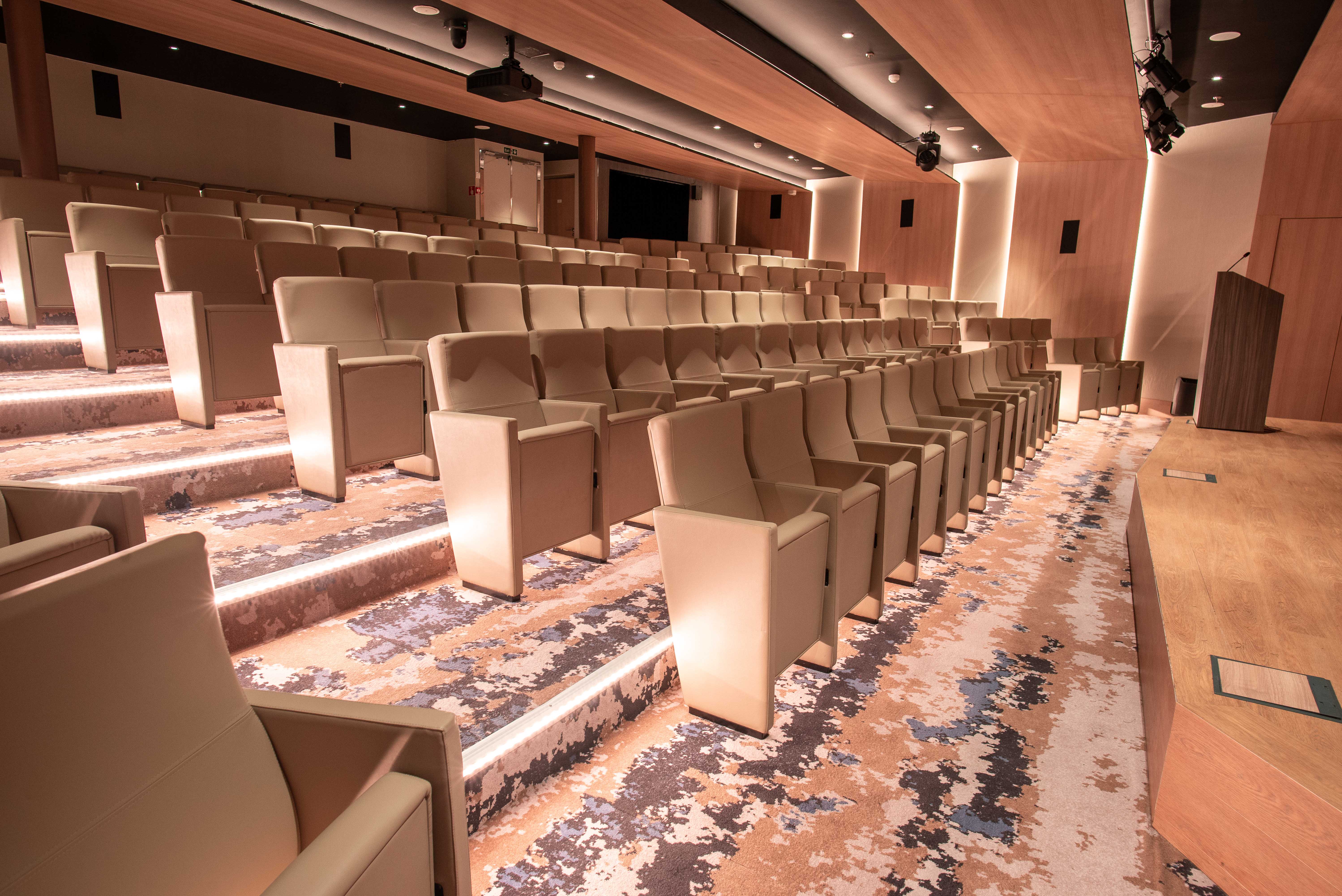
Our theater-style auditorium on Deck 4 can easily accommodate everyone on board, so it serves as our main hall where presentations and videos are provided for your education and enjoyment.
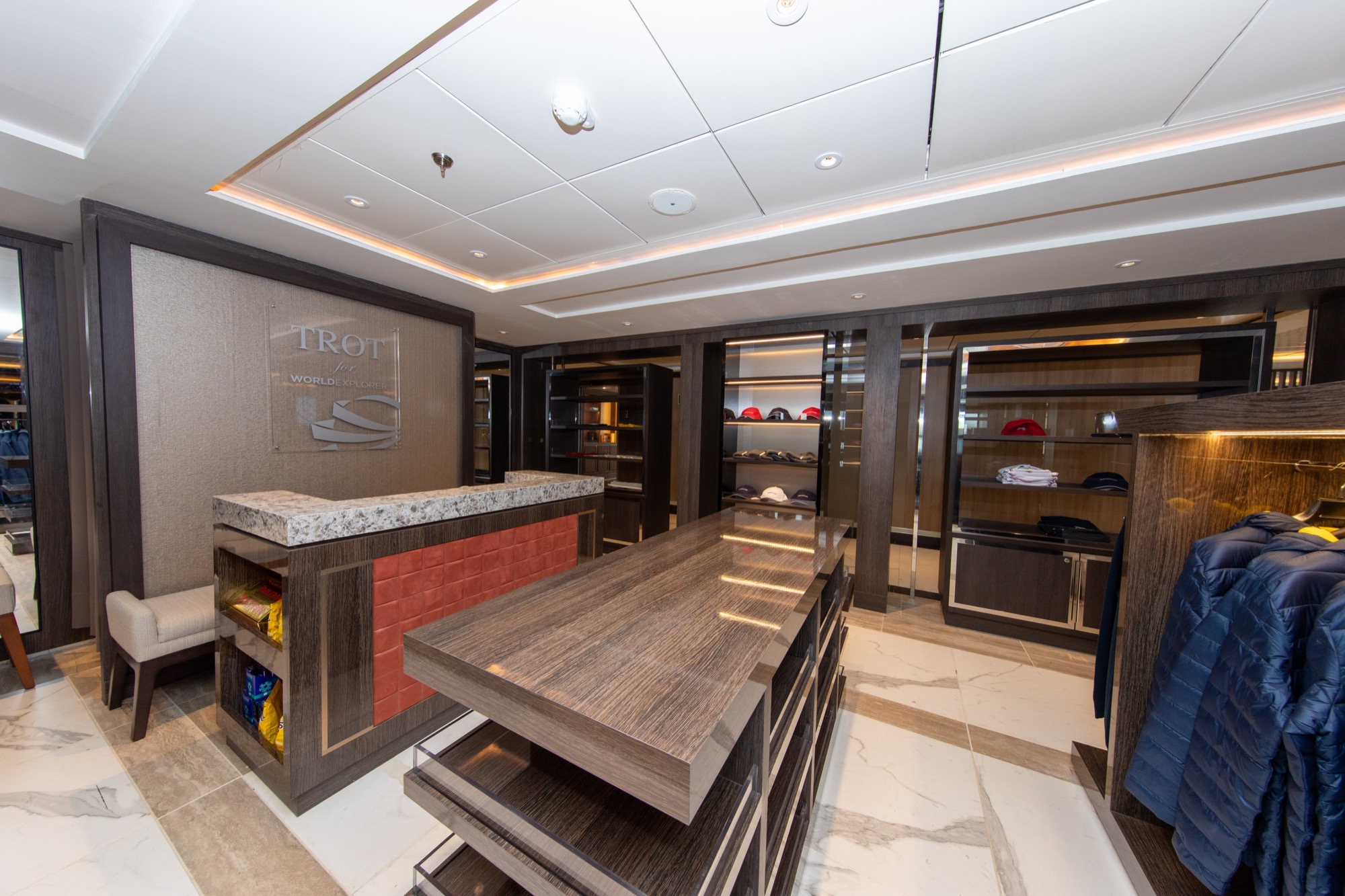
If you forgot any essentials or need a little souvenir from your voyage, the Polar Boutique on Deck 4 is our onboard gift shop. Opening hours will vary based on the daily expedition activities. Gifts and souvenirs are great to bring home as mementos of your polar expedition. In addition to small souvenirs, our Polar Boutique offers a selection of expedition gear, including base layer clothing, waterproof pants, gloves and more.
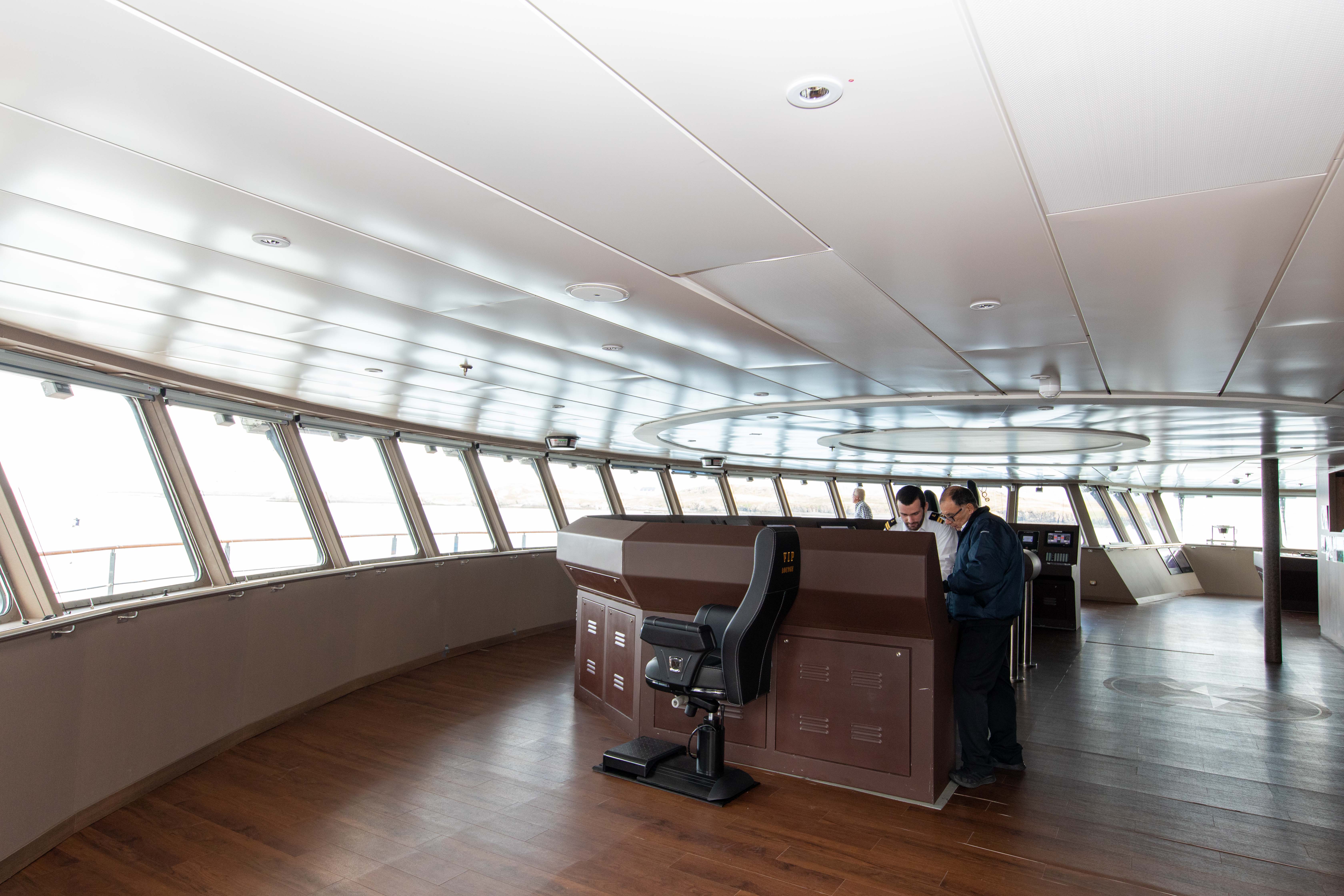
During your voyage you may be given access to the Bridge, where you can observe how the Captain and officers sail and navigate the ship.
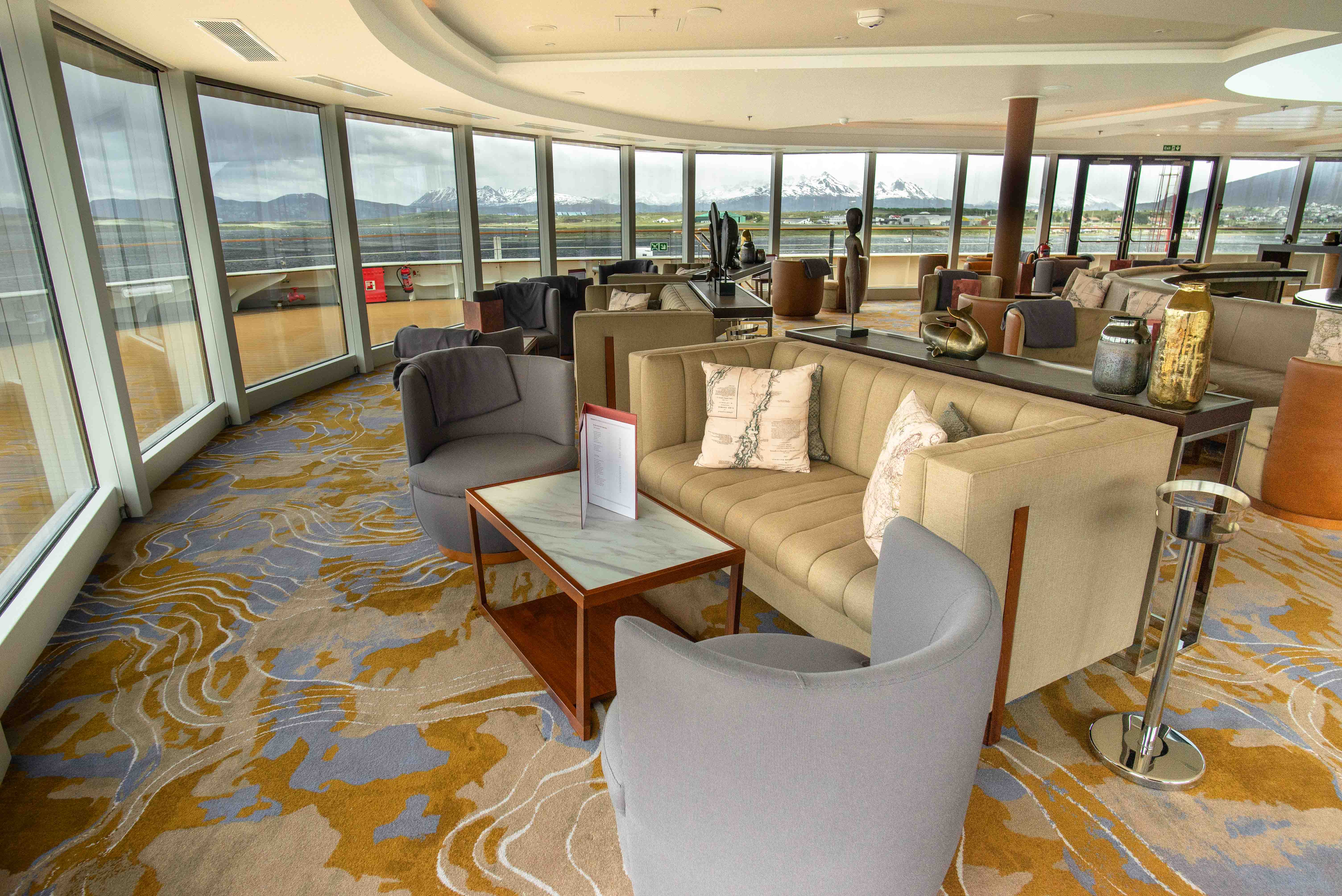
The glass-domed Observation Lounge on Deck 7 is a comfortable spot to relax and enjoy panoramic polar views.
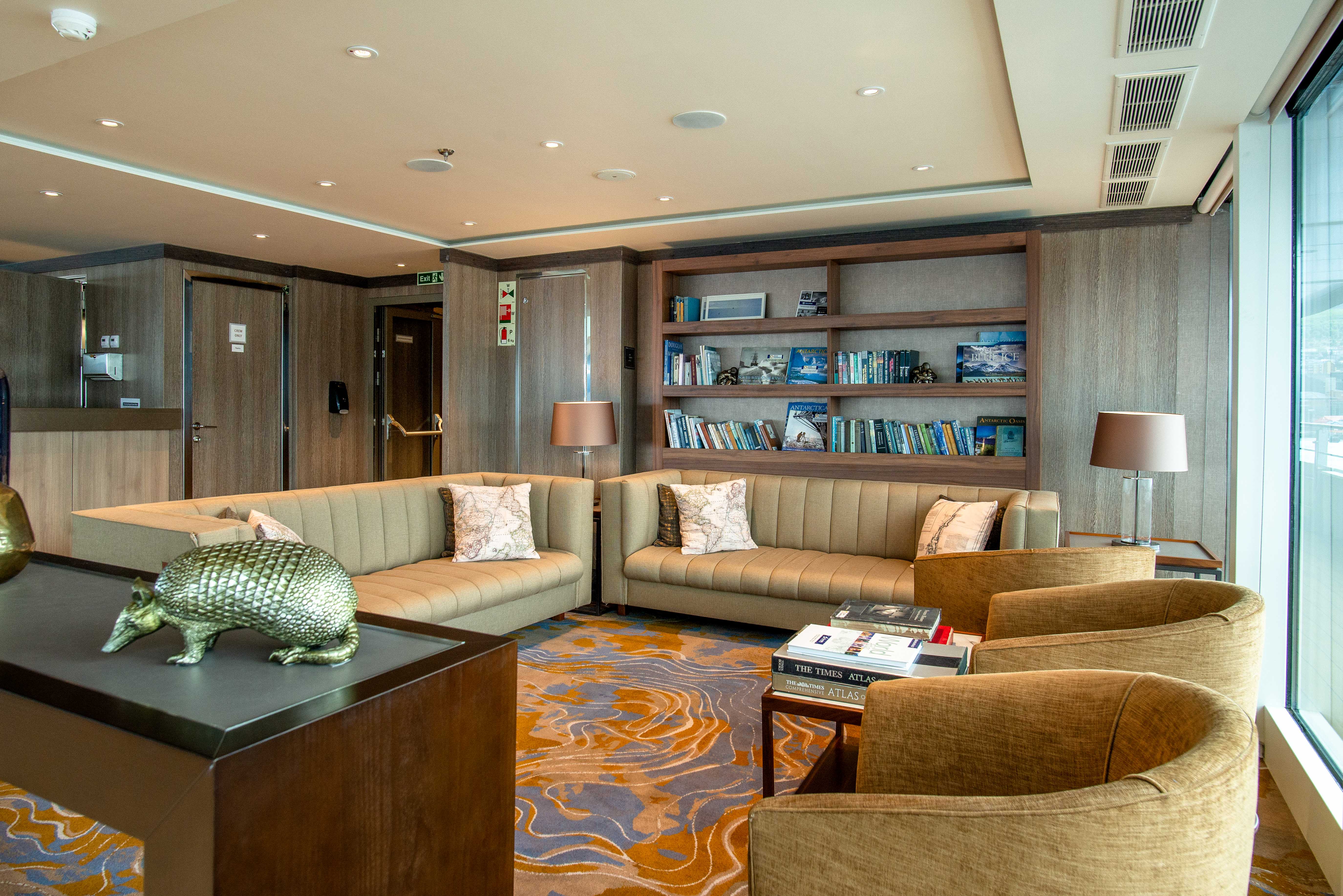
Located on in the Observation Lounge on Deck 7, the library includes a selection of field guides, picture books and reference books. Whatever your personal interests are, we’re sure you’ll find something worth reading. The World Explorer collection includes books in multiple languages covering subjects like wildlife, history, marine biology, ecology and geology.

A crew member is available at reception to assist you or answer any questions during posted hours. You can purchase internet access cards here, arrange for a wake-up call or settle your accounts at the end of the voyage.
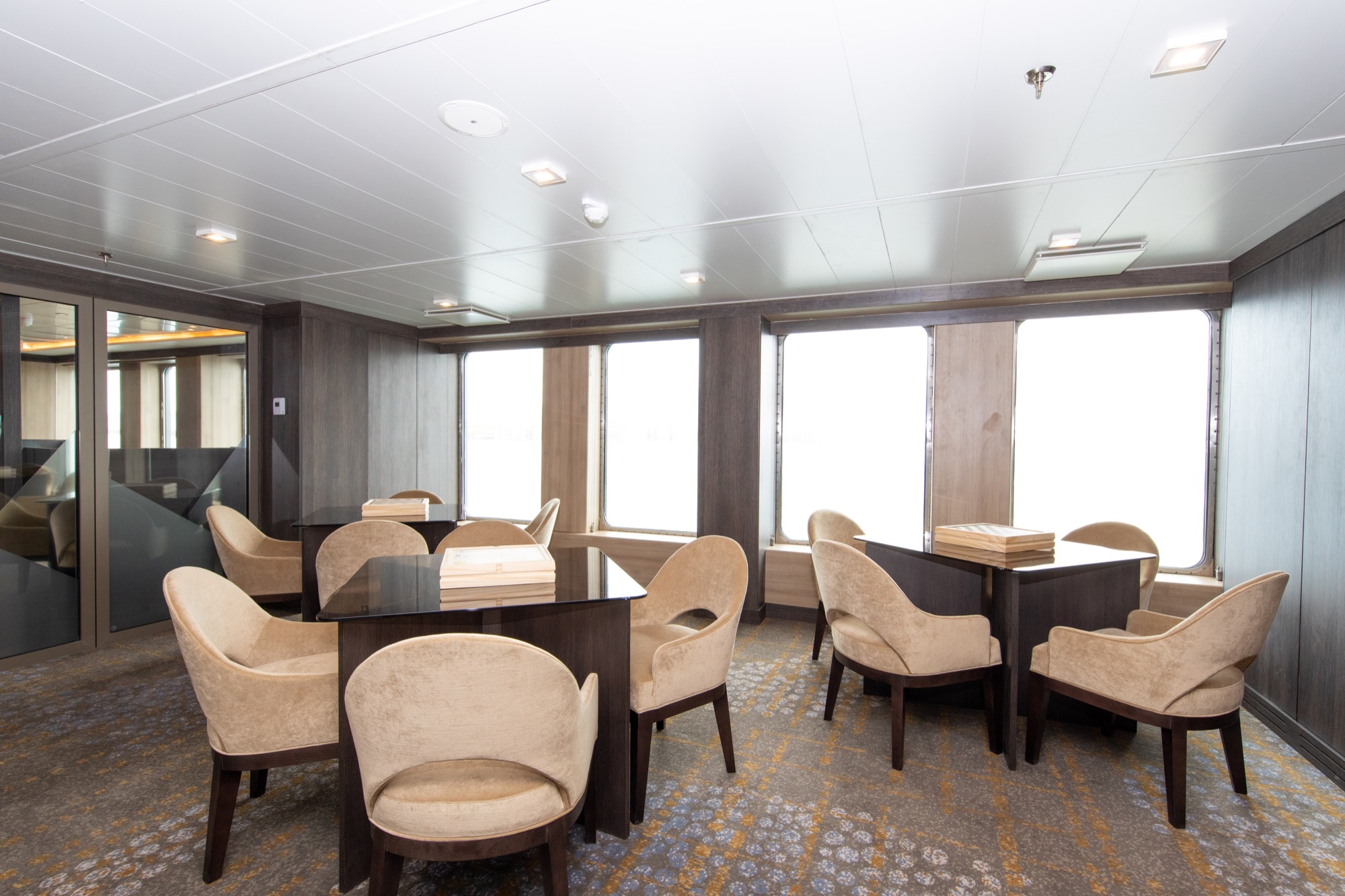
Located on deck 4.
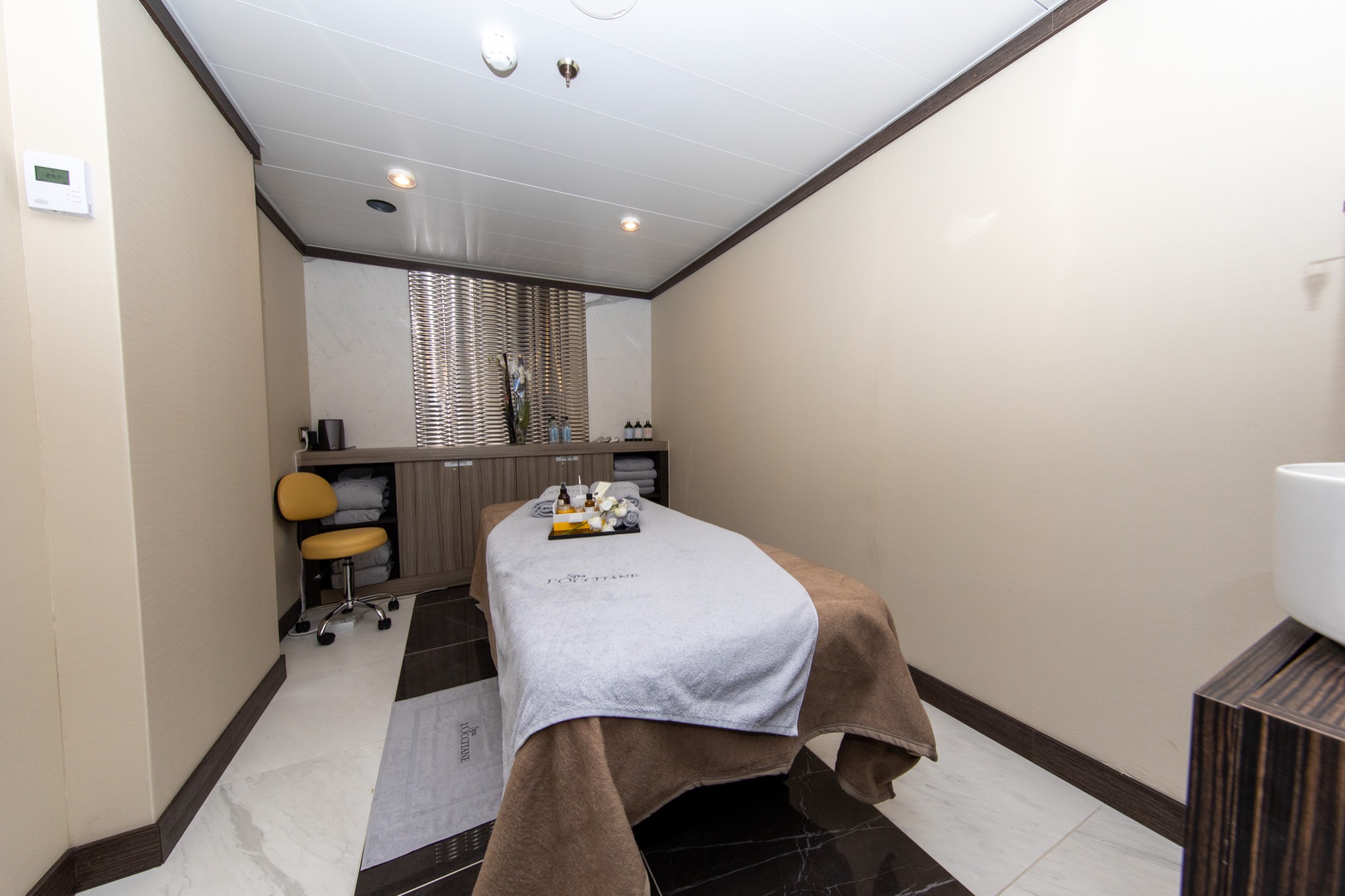
The spa is located on Deck 7 and offers massages, facials, and hand and foot treatments using L’Occitane products.
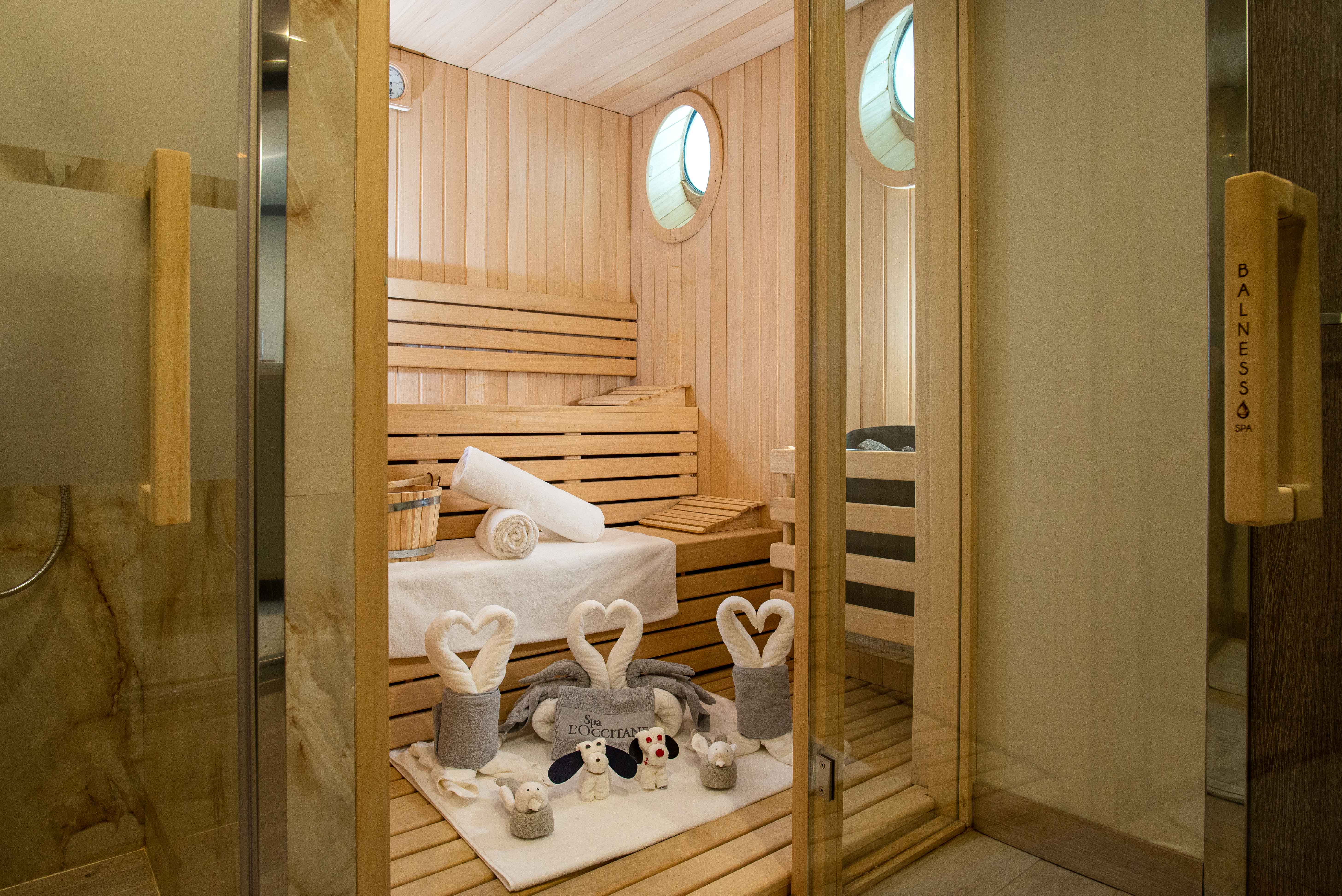
Indulge in Health & Wellness amenities like the Sauna located on Deck 7 which also has a corresponding change room and shower.

Deck 7 features a large heated outdoor pool, surrounded by deck space, and flanked by two hot tubs.
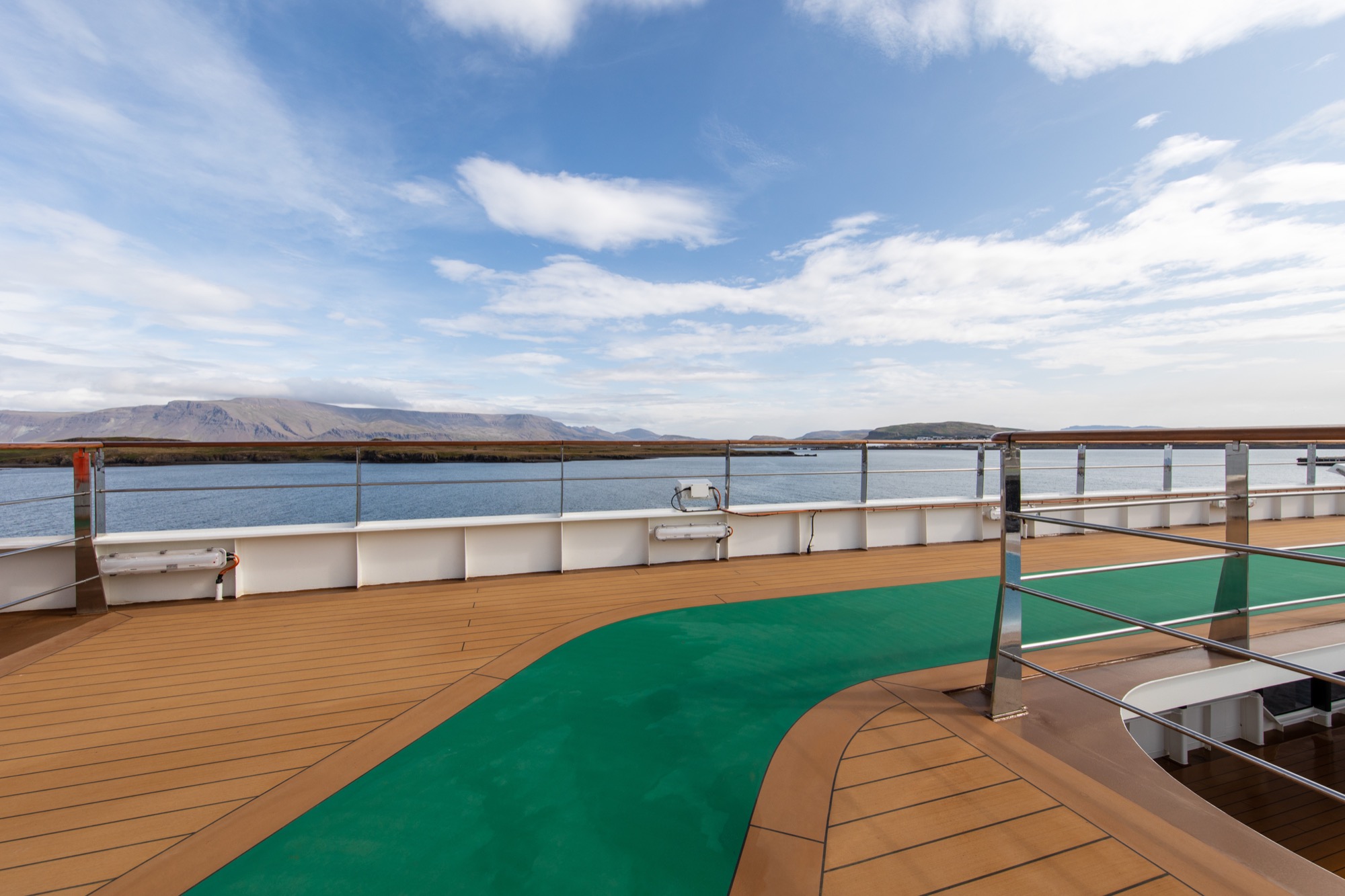
The Outdoor Track on Deck 8 offers a great way to stay active while aboard World Explorer; get your steps in while also enjoying the stunning landscapes and wildlife viewing opportunities the Polar Regions have to offer.
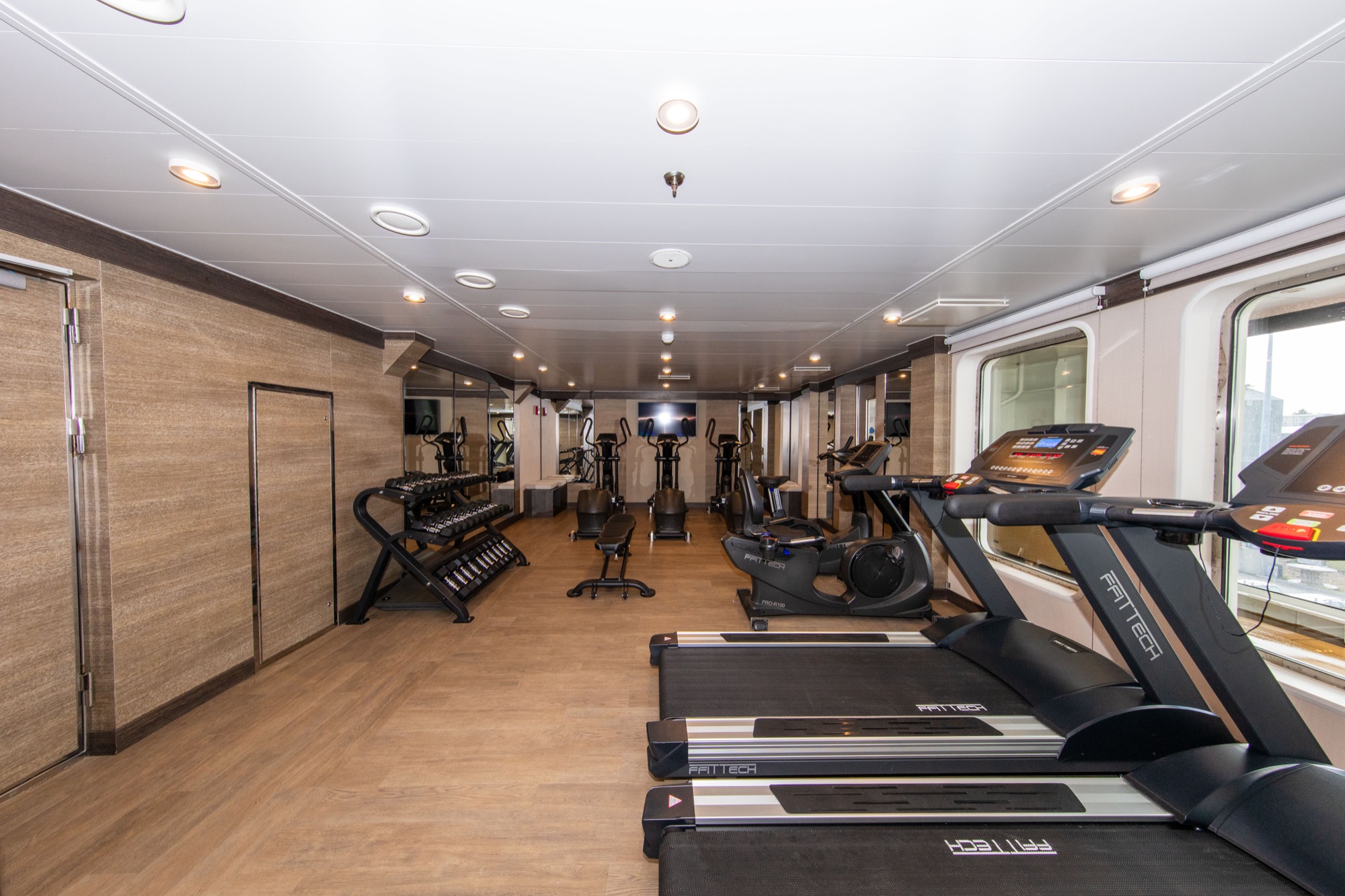
Located on Deck 7, fitness center hours are posted at the door, with facilities available on a first come, first served basis.
DOCTOR
Quark provides an English-speaking doctor on board who manages a medical clinic stocked with a supply of common prescription medicines and basic first aid equipment. If you are under regular treatment for any ailment, you must bring a sufficient supply of medicine for yourself. We cannot accept responsibility for not having a specific brand or type of drug on board. Should you fall ill, the doctor will refer to the medical forms that you completed and returned to us; therefore it is vital that the information you provide is complete and accurate.
MEDICAL CLINIC
The Clinic is located on Deck 4. In case of emergency, the doctor is available 24 hours a day, and can be contacted through reception or any member of the Expedition Team.
The dress code on the ship is casual, though some may choose to dress up a little for the Captain’s Welcome Reception.
To protect the health and safety of its guests, Quark Expeditions® maintains a no smoking or vaping policy in the interior of the ship including cabins, near Zodiacs and on landings. Smoking or vaping on the ship is permitted in the designated smoking area only, which your Expedition Team members will be happy to point out for you. Always make sure to extinguish cigarettes properly and dispose of them in the proper receptacle. Please, never throw cigarettes overboard.
If you do not eat meat there is a wide selection of vegetables, pasta, grains and fruit available. Quark Expeditions® is able to cater to most special dietary requests, as long as you clearly indicated your needs on the required expedition forms when you booked your voyage.
Menus will be clearly labeled for vegetarian and gluten free options, but please do notify your server of the dietary restrictions you indicated on your form. We regret that kosher food cannot be prepared.
Laundry service is available on every ship. Costs are reasonable. Excess baggage charges will often exceed laundry charges, so we recommend that you pack fewer items and use the laundry service to refresh your wardrobe.
Quark Expeditions welcomes passengers age of 8 and above on all trips with a signed waiver by a parent prior to trip commencement. There are however some caveats and restrictions to be aware of:
Children on Ship-based trips
Quark Expeditions welcomes passengers age of 8 and above and under the age of 16 at time of travel with a signed waiver by a parent prior to commencement on any Quark Expeditions trip, provided they meet height and weight requirements (weight of 64lbs or 29kg and 48″ or 1.2 m. tall). Children under 8 years old at the time of travel are not allowed to participate in the trip.
Children Ship-based Adventure Options
Adventure Options on ships are available for all persons over the age of 16. Children under the age of 16 are not allowed to participate in Adventure Options. Parents must be with children under the age of 16 at all times, so the parent’s participation in Adventure Options may be limited.
What is life like on an expedition? During days at sea, you’ll enjoy lectures and workshops presented by our Expedition Team and spend time on deck looking for seabirds and cetaceans. Other days are packed full with multiple landings,
Zodiac cruises and activities. Exhausting or relaxing, smiles abound as do great meals from your onboard chefs! We have a number of policies and procedures that help make sure things run smoothly on the World Explorer, so take a look below to help get the most out of your time aboard.
SCHEDULE CHANGES
While a daily program will be posted, sometimes new opportunities present themselves on short notice – so expect the unexpected and enjoy knowing that staff members are always here to make sure your expedition is as memorable and enjoyable as possible!
SAFETY ON BOARD AND ASHORE
Your safety and security is a top priority for our Expedition Team and crew members. Knowing how to safely move about your ship, act ashore and handle both wet and dry landings will help ensure you have a hassle-free expedition. Please take time to read the instructions in this important safety section.
SAFETY WHILE ON DECK
Be careful while walking around the outer decks, as footing can be slippery. Always use the handrails and wear proper closedtoe, nonslip footwear. Slip-on sandals, slippers or flip flops are neither safe nor suitable for wearing on board.
STAIRS & DOORS
There are high steps in many doorways that lead to the outer decks, please watch your step and proceed with caution. When passing through doorways or walking in your room, do not place your hands around the edges of doors. Be aware that if doors are not closed or latched open properly, they present a danger and can open or close violently and unexpectedly as the ship moves across the sea.
SAFETY BRIEFING & LIFE BOAT DRILL
By international maritime law, you must participate in an emergency drill within 24 hours of sailing. Upon embarkation, you will have a safety briefing to outline appropriate behaviour on board, and emergency procedures. Afterward, a drill will be conducted to familiarize you with your lifeboat, life vest and emergency evacuation route. This mandatory drill will be scheduled as soon as possible by the Expedition Leader. You will be provided with full details after you embark.
CONDUCT ASHORE
- For safety reasons, never walk alone while ashore. Always travel with someone else, or as part of a group.
- If weather conditions deteriorate the Captain will sound the return to ship signal (continuous short blasts). If you hear this, immediately return to the landing area or follow instructions from staff members.
- Do not litter. Take only photos and leave only footprints.
- Be punctual, as on time boarding and efficient landings mean we’ll have more time to explore at future landings.
WATER
All passengers receive an eco-friendly, reusable water bottle in their cabin upon arrival. You can refill your water bottle at any of the bars on board, or at the self filling stations on Deck 4 across from the Polar Boutique, or on Deck 3 in the mudroom.
ON BOARD ACCOUNTS
To make things as stress-free as possible, items you purchase from the Polar Boutique, lounge or bar (including drinks) are charged to your ship account. Cabin charges can also include laundry, postage, communication charges and adventure options booked onboard (space permitting). Payments of shipboard accounts are made towards the end of the expedition, at the reception area. The US dollar is the standard currency on board. You can use cash, Visa or MasterCard credit cards to pay your shipboard account. Personal checks are not accepted.
Note: If you are sharing a cabin and would like separate accounts, you must advise reception.
GRATUITIES
We understand this is a very personal subject and whatever amount you give is at your own discretion. As a guideline, we suggest the amount of US$15 to US$20 per traveler per day. At the end of the voyage you will have the option to charge a gratuity amount to your onboard account, or to place cash in an envelope. Gratuities are shared among our hotel and expedition team members.
ANNOUNCEMENTS
Announcements over the ship’s public address system will alert you to wildlife sightings, itinerary changes, and landing instructions for going ashore. Announcements can be heard in cabins and all public spaces. On some voyages, where Quark Expeditions Language Programs are scheduled, announcements in English will be repeated in other languages. Out of courtesy to other travelers, we ask that you remain quiet during all announcements – even those made in languages that are not your own.
BRIDGE VISITS
During your voyage you may be given access to the Bridge, where you can observe how the Captain and officers sail and navigate the ship. However, the Captain and Bridge officers do restrict access during arrivals and departures from port and during times of complicated navigation. As the Bridge is an important working area on the ship, we ask that you keep noise to a minimum to avoid distracting the officers from conducting their jobs efficiently. Understandably, Bridge etiquette includes a ‘no eating, drinking or smoking’ policy.
ENVIRONMENTAL POLICY
Help us take care of our environment! To keep our land and waters clean, kindly use all trash receptacles on board. Never throw anything over the side of the ship. Due to the complicated process of desalinating sea water for use on board, guests are asked to practice water conservation at all times.
BATTERY DISPOSAL
Please do not throw old batteries in your cabin garbage. Kindly bring them to reception for proper disposal.
LOST & FOUND
If you find any misplaced items, please bring them to reception or give them to a member of the Expedition Team. If you lose anything yourself, advise our staff so that they can assist you
STAYING IN TOUCH WHILE ON BOARD
When you are not busy exploring the natural beauty of the Polar Regions, you may have the ability to make phone calls, check emails and use the internet while on board.
Please note that we travel to some of the most remote parts of the world. As we utilize satellite equipment for our connection, it is possible that occasional degradation or outages of services may occur. Personal communication services are not always guaranteed throughout your voyage. We encourage passengers to disconnect from digital life and reconnect with the natural world.
To access email or internet on your personal computer, tablet or smart phone, you can purchase a data PIN card from reception. You can access network spots found throughout the public spaces of the ship. In some cases, the connection will also work from your cabins; however the best connections will be from public areas.
Current prices for these optional services will be posted on board the ship. Please note we cannot provide refunds for unused voice or data cards.
Please note that due to the connectivity technology of the ship, your cellular devices may be able to receive a signal, connecting to networks on shore in your embarkation country. Data charges may be applied by your cellular provider, and may add up quite quickly. It is safest to turn on airplane mode and turn off data roaming unless you are trying to connect. You may still enable wifi in airplane mode.
ONBOARD WEBSITE
Our intranet website on board is an excellent resource for daily programs, expedition team biographies, photos, and other voyage information.
Log on to http://www.MyQuarkVoyage.com during your expedition to take advantage of the materials. Access to this site is available free of charge, even if you have not purchased data.
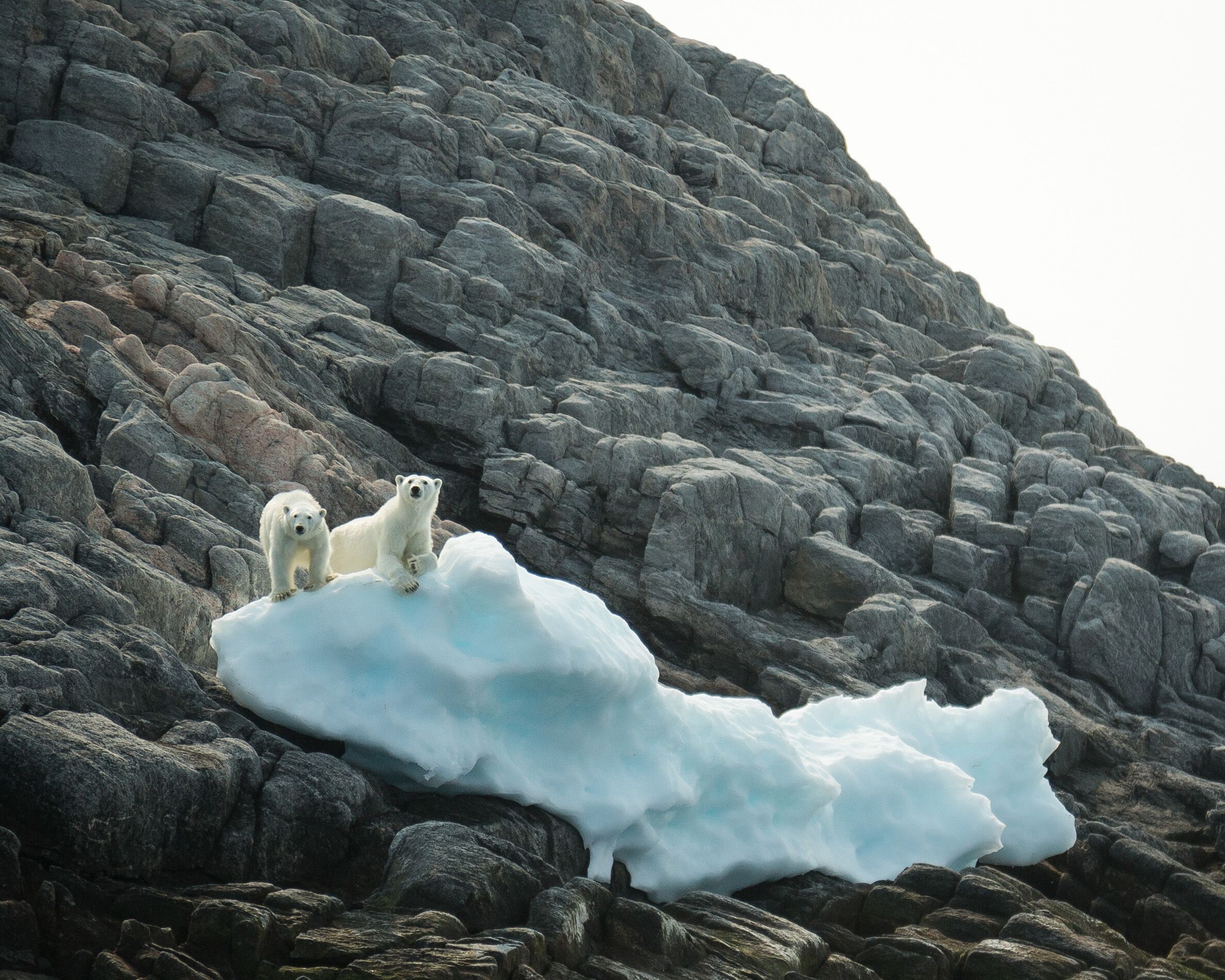
Quark Expeditions is profoundly committed to environmentally responsible tourism. Protecting the places we visit is necessary to ensure we can continue to introduce travelers to the spectacular beauty of the polar wilderness. Through Polar Promise, our comprehensive sustainability strategy framework, we’ve incorporated existing sustainability initiatives into a cohesive plan so we can identify where we can do better or do more.
“Quark Expeditions recognizes its responsibility to do more to protect these magnificent places,” says Andrew White, President of Quark Expeditions. “We want to go beyond reducing our footprint. We want to work with other leaders in the industry and with our guests to address the complex and challenging issues facing the polar regions.”
Our Polar Promise framework is made up of four pillars. Each addresses a different aspect of our business, our operations—and ultimately your journey.

Quark Expeditions aims to be the leader in responsible polar tourism, the ‘go-to’ operator for conscious travelers and the preferred partner of the world’s most responsible brands. As a polar-focused tourism operator, our sustainability principles are integral to every decision we make, whether it’s in the polar wilderness or in the places we work every day. We employ the best people in the industry and will lead the industry in the diversification of our workforce. We work to reduce our impact, catalyze change in the industry and help improve our suppliers’ operations.
We’re proud, long-time members in key industry organizations, such as the Association of Arctic Expedition Cruise Operators (AECO) and the International Association of Antarctica Tour Operators (IAATO). We adhere to these organizations’ stringent guidelines, which are designed to ensure the Polar Regions are protected for future generations.

When it comes to our footprint, the most substantial impact we can have is how we get you, our guest, to the remote Polar environments and how we preserve those majestic environments once we get there.
Quark Expeditions aims to reduce our carbon emissions per passenger by 10% through fleet improvements and changes in order to reduce our impact. We’re working with our supply chain to measure, report and reduce their emissions, and our office and field operations aim to reuse or recycle 100% of waste on Quark Expeditions-owned vessels.
In 2019, an analysis of our historical ship fuel consumption showed that we decreased emissions by 13% from the 5-year average emissions per passenger per day. The purpose of this analysis was to establish a baseline and to further reduce our Scope 1 carbon emissions.
In terms of waste, Quark Expeditions has taken steps to reduce the amount of waste we are sending to landfills, including avoiding single-use plastics and partnering in the SeaGreen recycling initiative in Ushuaia. We’re working towards a zero-waste plan on Quark Expeditions-owned vessels.

Quark Expeditions aims to be the leading expedition investor in outreach projects within the polar regions, working with a wide circumpolar network of scientists, community leaders, and sustainable innovators. Our goal is to contribute a minimum of $500,000 USD each year through in-kind donations, Quark Expeditions funding, and funds from passenger auctions in support of key polar environmental research, community engagement and sustainable development projects.
Nalunaiqsijiit, the Inuit Cruise Training Initiative, is a program dedicated to providing Nunavummiut with the qualifications and certifications required to work onboard expedition cruise ships, through in situ training and experience onboard ships. Quark Expeditions is excited to have hosted two Nalunaiqsijiit interns onboard Ocean Adventurer during the 2019 Arctic season, and have invited an additional four during the 2019/20 Antarctic Season.
Thanks to our guests’ support, proceeds from Quark Expeditions’ onboard auctions have contributed an average of $200,000 each year to organizations dedicated to polar environmental research, community engagement, and sustainable development projects.
Some of the organizations we’re supporting this year include the South Georgia Heritage Trust, Penguin Watch, Seabird Watch, and Polar Bears International.
Because Quark Expeditions’ fleet of small polar vessels carry a maximum of 199 guests, there’s an almost instant camaraderie and intimacy that you won’t get on larger cruise ships. Within your first day or two of your expedition, you’ll be on first-name basis with many of your fellow guests, as well as with members of the Expedition Team. That invariably means you’ll spend time together on ship sharing your day’s adventures, showing one another favourite wildlife photographs taken during your off-ship adventures—quite possibly over a drink in one of the on-ship bars or lounges.
Great news! As of our Antarctic 2024/25 sailing season, beer, standard wines and spirits, as well as cocktails, will be available to guests at no charge during bar service hours and dinner as part of our “Raise a Glass and Stay Connected” campaign. This complimentary bar service is available to all guests.
Just as our free Wi-Fi will help you stay connected with friends and family, our complimentary bar service helps you connect and spend time with your fellow guests on your voyage. After all, making connections is one of the most memorable experiences of exploring remote parts of the Arctic and Antarctic regions with like-minded travelers.

- Sun Deck

- Pool
- Spa
- Gym
- Observation Lounge

- Bridge
- Infinity Suite
- Triple
- Veranda Suite
- Superior Suite
- Owner’s Suite

- Infinity Suite
- Deluxe Suite
- Veranda Suite
- Superior Suite
- Owner’s Suite

- Restaurant
- Polar Boutique
- Library
- Reception
- Explorer Lounge
- Bar
- Lecture Theatre

- Zodiac Boarding
- Mudroom

